



























Inside: Hydrogen Valley | Sustainable mining | Alternative agriculture | EV Evolution | Energy investments | Job creation THE RENEWABLE REVOLUTION



9 NATIONAL DEVELOPMENT PLAN
The National Development Plan sets ambitious targets for transforming South Africa’s energy sector, but is it still feasible?
15 HYDROGEN VALLEY
A deep dive into the plan to establish a “hydrogen valley” anchored in the platinum group metals-rich Bushveld geological area

18 THOUGHT LEADERSHIP: THE NEW ENERGY ACTION PLAN
Government’s new energy action plan sends a positive message to the market, industry and private investors looking to invest in renewable energy
19 THOUGHT LEADERSHIP: DIGITALISATION AND ENERGY
Digital technologies are set to make energy systems around the world more connected, intelligent, efficient, reliable and sustainable
21 LEVERAGING LITHIUM


Despite having almost no lithium reserves, South Africa has the potential to play a major role in global lithium-ion battery production

Contents
24 MINING AND ENERGY EFFICIENCY

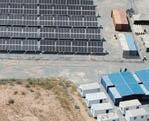


Mining is a power-intensive business, but recent efforts by the sector are proving to be important catalysts for energy efficiency
28 THOUGHT LEADERSHIP: MINING’S TRANSITION TO RENEWABLES
In order to overcome the ongoing power crisis, mining companies are actively diversifying their energy mix
29 THOUGHT LEADERSHIP: DOUBLING INVESTMENT IN THE GREEN ECONOMY

Nedbank explains why it is vitally important that efforts are made to double financing efforts within the green economy

30 ALTERNATIVE AGRICULTURE
The agricultural industry was an early adopter of alternative energy sources, but how much of this sector’s power can realistically be obtained from them?

32 GOING SOLAR
Everyone wants off the grid, but what is the real feasibility of implementing comprehensive renewable energy solutions in residential areas?

36 ELECTRIC VEHICLE EVOLUTION
Unpacking the current state of South Africa’s electric vehicle market in light of skyrocketing fuel prices driving greater demand

43 INVESTMENT IN ENERGY
Investment in the renewable energy sector is vital, but questions remain around how to obtain funding


45 THOUGHT LEADERSHIP: BID WINDOW 6 AND THE LAW

The legal ramifications around the increase in maximum contracted capacity, the way bidding consortia are assembled and the decommissioning of power plants

48
GENDER EQUALITY
The transition to clean energy offers the industry a clearer chance of discarding its male-dominated image and embracing gender equality
51 JOB CREATION
The emerging energy sector holds enormous potential for job creation and economic development – but is not without challenges
52 THOUGHT LEADERSHIP: RENEWABLE ENERGY BUSINESS SOLUTIONS
There is great potential for SMEs across the value chain to benefit from the growing demand for sustainable and renewable energy solutions.
ENERGY 3 IMAGES: SUPPLIED, BLUE PLANET STUDIO/ISTOCKPHOTO.COM
24 15 36
SUPPORTING RENEWABLE ENERGY
With fuel prices at unprecedented highs, ongoing load shedding from Eskom and the effects of climate change becoming more apparent by the day, the need to transition to renewable and sustainable forms of energy has never been greater.

While government’s new energy action plan has received praise, industry and the private sector need to make increasing efforts to support renewable energy too. Agriculture, for instance, was an early adopter of renewables. Looking at it from an investment point of view, says Simon Grier on page 30, renewable energy ticks every box for the agricultural sector. Mining is fast becoming a leader in energy effi ciency as well. On page 24, the Minerals Council South Africa shares how mining companies are moving towards sustainable, renewable sources of energy to reduce their carbon footprint and ensure the minerals they produce are globally acceptable. They also add that there is a strong element of reducing exposure to electricity sourced from Eskom, which generates more than 80 per cent of its electricity from coal, bringing with it carbon tax, and social and environmental consequences. Financial institutions like Nedbank are also seeking to double their fi nancing efforts in this sector.
There is much discussion around South Africa’s plan to invest in a “hydrogen valley” to support the development of hydrogen as a new type of energy, as well as plans to gain traction in the lithium value chain amid the growing demand for electric vehicles.
There are many other facets to renewable energy too. It offers the energy industry a chance to embrace gender equality more
Page 18: “The planned battery energy storage to supplement Eskom’s capacity represents a multifaceted approach to the energy crisis, opening up the energy storage market to private investment.”
– Janice Foster
Page 21: “South Africa is currently the only country in the world, outside of China, that refines battery-grade manganese.” Gaylor Montmasson-Clair
effectively, it holds the potential to create jobs on a scale not seen before, and the digitalisation of the sector will drive signifi cant improvements in effi ciency.
Of course, everyone who has suffered power outages has considered going “off-grid”, so we take a look at the ins and outs of this process, and whether it is even feasible in South Africa.
We also take a look at how the repurposing of good fuel cells from discarded electric vehicles batteries, for the stationary energy storage market, plays directly into the circular economy, and investigate the legal implications around the sixth and latest Renewable Energy Independent Power Producer Procurement Programme bid window.
While South Africa is no doubt faced with energy struggles for the foreseeable future, the incisive articles in this edition demonstrate that there is certainly a light at the end of the tunnel – a renewable one that won’t be subject to load shedding!
Rodney Weidemann Editor
PUBLISHED BY
Picasso Headline, A proud division of Arena Holdings (Pty) Ltd Hill on Empire, 16 Empire Road (cnr Hillside Road), Parktown, Johannesburg, 2193 PO Box 12500, Mill Street, Cape Town, 8010 www.businessmediamags.co.za

EDITORIAL
Editor: Rodney Weidemann
Content Manager: Raina Julies
rainaj@picasso.co.za
Contributors: Lindi Botha, Trevor Crighton, Mike Davis, Janice Foster, James Francis, Gareth Griffiths, Raghemah Hendricks, Dale Hes, Amber Kardamilakis, Corne Louw, Minnette le Roux, Nicolas Marsay, Robin Melville, Jackie Midlane, Itumeleng Mogaki, Anthony Sharpe, Benjamin van der Veen, Roland Verwey
Copy Editor: Anthony Sharpe
Content Co-ordinator: Vanessa Payne
DESIGN
Head of Design: Jayne Macé-Ferguson
Senior Designer: Mfundo Archie Ndzo
Advert Designer: Bulelwa Sotashe
Cover Image: bombermoon/istockphoto.com
SALES
Project Manager: Gavin Payne
GavinP@picasso.co.za | +27 21 469 2477 +27 74 031 9774
Sales: Corne Louw, Brian McKelvie
PRODUCTION
Production Editor: Shamiela Brenner
Advertising Co-ordinator: Johan Labuschagne
Subscriptions and Distribution: Fatima Dramat, fatimad@picasso.co.za
Printer: CTP Printers, Cape Town
MANAGEMENT
Management Accountant: Deidre Musha
Business Manager: Lodewyk van der Walt
General Manager, Magazines: Jocelyne Bayer
Copyright: Picasso Headline.

No portion of this magazine may be reproduced in any form without written consent of the publisher.
The publisher is not responsible for unsolicited material. Energy is published by Picasso Headline.
The opinions expressed are not necessarily those of Picasso Headline. All advertisements/advertorials have been paid for and therefore do not carry any endorsement by the publisher.
FROM THE EDITOR 4 ENERGY
www.businessmediamags.co.za


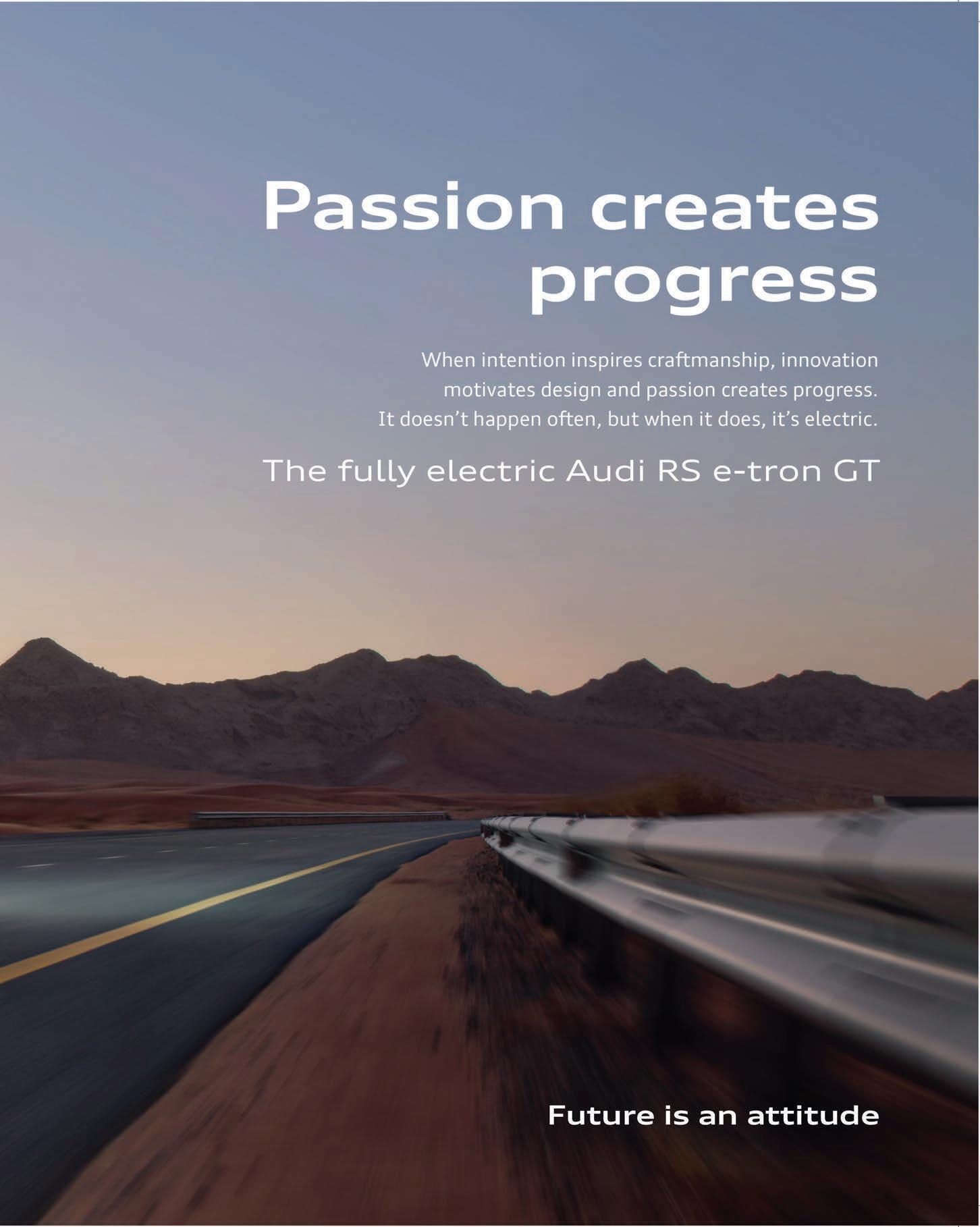

Planning for more power
years. So yes, meaningful progress has been made in this regard.”

After nearly a decade-and-a-half of load shedding, it seems almost trite to say South Africa faces a power crisis. Crisis, emergency, disaster – whichever word you choose to describe the picture, it is dire, and it’s getting worse. In April this year, Eskom cut 1 054 gigawatt-hours of power, compared with 2 521 gigawatt-hours for all of 2021. The scale of those cuts was blamed on a strike at the power utility, but that spontaneous event occurred against a backdrop of steady mismanagement, vandalism and lack of maintenance.
It wasn’t meant to be this way. The National Development Plan (NDP), drafted in 2012, set out ambitious economic growth targets, along with steps towards honouring South Africa’s commitment to reduce carbon emissions below a baseline of 34 per cent by 2020 and 42 per cent by 2025. The NDP was developed in line with the Integrated Resource Plan (IRP), promulgated in 2011. However, according to Climate Action Tracker data, from 2012 to 2020, the country managed just a 9.2 per cent decrease. Without coal, unfortunately, the country stands little hope of keeping the lights on, and Eskom burns 9 million litres of diesel daily to offset plant outages.
In the meanwhile, the National Planning Commission (NPC), an advisory body to government on development and policy, has called for 10 000MW of solar and wind power, along with 5 000MW of battery storage, to be built within the next three years.


How do we get this plan back on track? Has government made any meaningful progress towards solving our energy and environmental problems?
Watt has happened so far
According to Prof Sampson Mamphweli, director of the Centre for Renewable and Sustainable Energy Studies at Stellenbosch University, there has been progress. “A lot has happened in terms of implementation of the IRP to bring in new generation capacity from mainly wind and solar sources,” says Mamphweli. “Government has introduced further measures to open up the electricity production space to allow for the involvement of more independent power producers. These efforts will result in a lot more new generation capacity coming online in the next three to four

The sentiment is echoed by Niveshen Govender, CEO of the South African Wind Energy Association. “Although coal has been the primary source of power in South Africa due to the low raw material cost, and will continue to feature in the country’s energy mix in the short to medium term, government has put policies and initiatives in place to ensure a transition to a more diverse, lower-carbon energy mix,” says Govender. “Given the commitment to the Paris Agreement, South Africa has been on the road to reducing its emissions for the past decade through various mechanisms.”

Govender says that much has been achieved in terms of the renewable energy targets, with 6 323MW of power successfully implemented through bid windows 1 to 4 of the Renewable Energy Independent Power Producer Procurement Programme (REIPPPP). He adds that a further 1 995MW was procured under the Risk Mitigation Independent Power Producer Procurement Programme and 2 583MW under REIPPPP bid window 5.
“This brings the total so far procured under the government’s procurement processes to nearly 10 000MW. This does not yet consider the 5 400MW expected in REIPPPP bid window 6 and the distributed generation projects.” ›
Prof Sampson Mamphweli







NATIONAL DEVELOPMENT PLAN ENERGY 9
The National Development Plan sets ambitious targets for transforming South Africa’s energy sector. But, asks ANTHONY SHARPE , is it still feasible?
“Government has introduced further measures to open up the electricity production space to allow for the involvement of more independent power producers.” Prof Sampson Mamphweli
Niveshen Govender
Keeping the plan on track
Much has changed in the past decade, from decreases in the costs of renewable energy installations to the unexpected catastrophic impacts of COVID-19 on the economy. All of which begs the question of whether or not the NDP is still valid.
“The NDP is such a large and complex plan because it looks at so many different elements around a sustainable future for the country,” says Dr Karen Surridge, acting general manager of the South African National Energy Development Institute, which conducts research in order to inform government policy around energy. “It addresses environmental sustainability, reducing emissions and moving to alternative energy sources, which will create redundancies in the fossil fuel space. But things shift over time, and the energy crisis is one of the things forcing a shift.
That’s why President Ramaphosa called the family meeting on energy. Government is reacting to the situation.”
Of course, the wheels of government turn slowly, especially when there are so many different departments involved, as there are with a situation as complicated as the one South Africa faces. This is one of the key challenges facing policy implementation around energy, says Govender.
“There remains a disconnect between energy policy and political will with regards to energy. Investor confidence require long-term policy certainty and political stability.”
Govender adds that our complex regulatory environment has not been conducive to the quick establishment of new generation capacity. “Environmental authorisation, permit applications, connection and regulatory processes remain long and tedious. There’s also a lack of coordination between key stakeholders: interdependency between different
“There remains a disconnect between energy policy and political will with regards to energy. Investor confidence require long-term policy certainty and political stability.” Niveshen Govender

DECLARING A CRISIS
One of the recommendations by the National Planning Commission (NPC) was that government implement emergency measures to deal with the energy crisis. These included removing the 100MW licensing ceiling, scrapping overly onerous registration processes through the National Energy Regulator of South Africa (Nersa) and replacing them with an online registration procedure for database purposes, streamlining environmental and water use approvals, and pausing local content restrictions.
On 25 July, President Ramaphosa announced five actions to address the situation, including improving the performance of Eskom’s current power stations, accelerating new generation capacity procurement, increasing private investment in capacity generation by removing the licensing ceiling for embedded generation, reducing some environmental requirements, and incentivising households and businesses to adopt rooftop solar. Prof Sampson Mamphweli says that acknowledging
the crisis and declaring these actions won’t necessarily make a difference; what matters is the implementation of the plan as announced by the president. “I am aware that there are various teams working on implementation of the plan through drafting of implementation strategies. The main issue will be whether South Africa has money to implement the plan.”
Ramaphosa said that government will take “a pragmatic approach” to local content requirements for new renewable capacity builds. Mamphweli believes that scrapping these requirements is a missed opportunity. “The opening of the electricity supply market would have brought a lot of investment in local manufacturing, which would have resulted in job creation.”
Niveshen Govender, of the South African Wind Energy Association, says that although localisation and industrialisation are key for the sustainable growth of the renewable energy industry, there have been major challenges implementing the local content requirements of previous
government departments is an obstacle to obtaining timeous responses.”
Mamphweli agrees that policy uncertainty remains an issue. “We had a break in the implementation of the IRP 2010 in 2014/15 when Eskom refused to sign the 27 REIPPPP projects that had been given preferred bidder status by the Department of Mineral Resources and Energy. That led to delays in the introduction of new generation capacity, and now we are catching up with the implementation of the IRP 2019 through various intervention measures announced by the president.”
Surridge says that while things don’t always move as quickly as industry and the public might want them to, the reality is that if the steps along the way aren’t carefully followed, there can be unintended consequences.
“Government is stuck between a rock and a hard place. Some aspects of the NDP are working, but people don’t see those as successes. Because when your lights are out during load shedding, you want an immediate response; you want someone to blame.”
She acknowledges that people are frustrated, but also emphasises that steering a whole country in a new direction will take time.
“Changing course requires all the players to be agreed on the same course. That doesn’t happen easily anywhere in the world. It’s not human nature.”
Renewable Energy Independent Power Producer Procurement Programme rounds. “A more inclusive strategy to achieve industrialisation needs to be considered.”
Local content will remain a contentious issue in a country that desperately needs industrial investment and job creation, says Karen Surridge, of the South African National Energy Development Institute. “Try telling locals where these projects are being built that you’re bringing in foreigners and paying them in dollars to do the work, and see what kind of reaction you get.”
Surridge emphasises that while everyone wants to see things happen faster, the correct procedures still need to be followed. “Nersa registration isn’t simply about filling out a form and filing it. They take that information and seeing how many projects are being registered in a particular area, and whether or not the grid can handle them all, and if not what needs to be done to accommodate projects. It’s not a box-ticking exercise; it’s to understand the broader context.”
NATIONAL DEVELOPMENT PLAN 10 ENERGY IMAGES: ANNASTILLS/ISTOCKPHOTO.COM, SUPPLIED
Dr Karen Surridge

GREENING AND GROWING THE REGIONAL ECONOMY AND LOCAL COMMUNITY

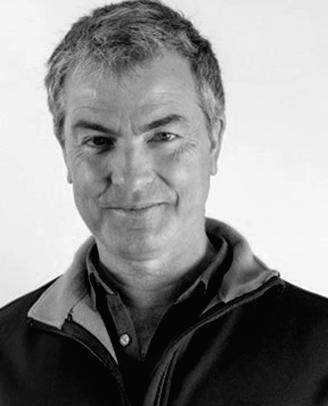
As a green industrial park housing manufacturers of green technologies, the ASEZ presents itself as an important role player in the broader enabling ecosystem of renewable energy projects.
ASpecial Economic Zone (SEZ) is typically defined as a geographic area in which the regular rules and policies applying to industry are different. This can take the form of incentives – in South Africa, one of these is a 15 per cent corporate tax rate – special conditions and/or other types of policies or programmes to attract investment and create jobs. In South Africa, the SEZ programme has typically been used to target development in underserved areas and communities. As a general rule, however, special economic zones are best used when a country wishes to pilot or test specific industrial policies that it is not ready to apply across the economy (policy testing), or, for various reasons, wants to limit to specific locations (spatial targeting). The SEZs in China, for example, were originally designed to test and apply a
more liberal, market-orientated approach to manufacturing and production within the context of a communist state, among other things.
The top priority for the Atlantis Special Economic Zone (ASEZ) is to work with the local community and government stakeholders to attract job-rich investment linked to growing the green economy. It is a combination of spatial targeting (Atlantis and surrounds) and targeting of greentech manufacturing within an eco-industrial park that promotes sustainable and green manufacturing practices. That is a lot – but right now, our focus is on jobs and local impact to build momentum for longer-term growth.
BENEFITS FOR THE COUNTRY
The SEZ aims to benefit the country from an economic, manufacturing and job creation perspective and will do so on several fronts
The top priority for the Atlantis Special Economic Zone is to work with the local community and government stakeholders to attract job-rich investment linked to growing the green economy.
– but two are worth emphasising. First, there is a strong emphasis on exploring how we can support the just transition to a green and sustainable economy. That means a heavy focus on building local skills and enterprises geared towards the green economy. Working with the local community to build shared value is also central to our value proposition. Second, we are targeting the development of a greentech manufacturing cluster. Our vision is to be Africa’s leading green manufacturing zone. Green manufacturing is no longer a nice-to-have – with increasing consumer awareness and growing requirements for low-carbon, resource-efficient goods and services (in some cases moving to law), it is the future of all manufacturing.
As a green industrial park housing manufacturers of green technologies, the ASEZ presents itself as an important role player in the broader enabling ecosystem of renewable energy projects and the roll out thereof. Components destined for these projects need to be manufactured in a suitable location that provides them with sophisticated green infrastructure, a level of energy security, and a green precinct rating, which further improves the manufacturer’s global competitiveness.
As a priority of all three tiers of government, the Atlantis Special Economic Company (ASEZCo) is well-positioned to provide rapid access to development approvals and one-stop-shop support. Benefits derived from clustering manufacturers together is another way in which the ASEZ presents value to renewable energy or other green technology component manufacturers.

12 ENERGY ADVERTORIAL ATLANTIS SEZ
The Atlantis Special Economic Company’s MATT CULLINAN , infrastructure executive; JARROD LYONS, business development executive; and MICHAEL WEBSTER , community integration specialist, explain what a SEZ is and chat about the skills development and community engagement that forms part of this initiative
Matt Cullinan
Jarrod Lyons
Michael Webster
FOCUS ON COMMUNITY ENGAGEMENT AND SKILLS DEVELOPMENT
We place a strong focus on community engagement and providing access to employment.
Community engagement has become more than a tick-box exercise. It involves stakeholders from multiple sectors with different viewpoints who enter into dialogue to ensure communities’ burning issues are highlighted. Traditional methods of the past have, in recent times, given way to a more direct, rooted approach that ensures that communities are at the forefront of projects. This approach allows the ASEZCo to work alongside the community, enabling our stakeholders to own part of the process, which creates effective partnerships.
Enabling and equipping community members with relevant skills is critical to their wellbeing and ensures residents have access to employment opportunities within the industrial area.
Some of the efforts being made in respect of training, internships and skills development include:
• Renewable Energy Workshop Assistant Training (and work placement).
• Technical Training opportunities.
• Early Childhood Development.
• Annual Career Expo.
• Mechanical Fitting Training.
Enabling and equipping community members with relevant skills is critical to their wellbeing and ensures residents have access to employment opportunities within the industrial area.
• Ikamva Youth multiyear afterschool tutoring programme for Grade 10s to Grade 12s. The 2021 academic year has been completed, and the programme is ongoing in this current academic year.
• Business Communication Training programme.
• Food Security and Ecosystem programme.
• Green Economy Workshops.
• Small, medium, micro and macro enterprises (SMME) support – involves knowledge sessions, including power hours.
GOING GREEN FOR SUSTAINABILITY
Green manufacturing is increasingly central to economic competitiveness in the context of growing consumer demands for sustainable goods and services. These demands are increasingly backed up by government
Green manufacturing is increasingly central to economic competitiveness in the context of growing consumer demands for sustainable goods and services.
regulations and targets around things such as the carbon content of goods. Having an SEZ with specific targets around net-zero carbon, net-zero water (positive water balance), net-zero waste to landfill, and working with nature, ensures that we are laying the foundations for truly green and sustainable production. A focus on inclusivity and building skills and enterprises off the manufacturing base also leads to social stability and resilience. These are all the cornerstones of what we believe must be the future of manufacturing.
economic zone

Scan this QR code to go directly to the Atlantis Sez website.

For more information: 087 183 7000 info@atlantissez.co.za www.atlantissez.com

ENERGY 13 ATLANTIS SEZ ADVERTORIAL special
➔
Land is available for investors to locate their manufacturing facilities in a globally competitive destination, the Atlantis Special Economic Zone.
GREEN ECONOMY INVESTMENT WILL DRIVE DEVELOPMENT AND JOB CREATION
THE ATLANTIS SPECIAL ECONOMIC ZONE for green technologies aims to harness the green economy for growth and increase job opportunities by driving sustainable development and job creation.
The Atlantis Special Economic Zone (SEZ) is a key element in the Western Cape government’s Economic Recovery Plan and the scheduling of the company as a provincial business enterprise bodes very well for its role as a game changer in the renewable energy sectors of the Western Cape’s economy.

The eco-industrial park seeks to attract investors that embody the elements and ethos of green technology manufacturing.
The Atlantis SEZ is run on green-economy principles, reduction of carbon, and promotion of resource-effi cient business activities, culminating in a socially-inclusive economy.
With the Atlantis Special Economic Company (ASEZCo) forming part of a mature and effective investment ecosystem in the Western Cape, any investment in the SEZ is sure to offer benefi ts.
GROWING THE REGIONAL ECONOMY
Atlantis presents itself as the ideal location from which to compete in Africa and the world’s green technology markets by offering green infrastructure, a strong support base from government, and fruitful business relationships for investors, as they work closely with the locals and help uplift the community. Green skills development and growing technical capabilities within the Atlantis community are part of the ASEZCo’s strategic objectives, aligned to the legislative requirement of the Special Economic Zones Act to grow the regional economy and drive socioeconomic impact.
The Atlantis SEZ has positioned itself as a world-class eco-industrial park and Living Lab. The responsibility of running the park on green-economy principles lies with the Infrastructure and Integrated Ecosystem (IES)
Driving growth through green economy innovation and sustainable job opportunities remains at the heart of what the ASEZCo does. These principles will contribute towards growing the regional economy in a meaningful and impactful way.
team. The IES team supports the Atlantis community through skills and enterprise development, coupled with community integration. The aim is to enable the Atlantis community, and particularly its youth, to tap into growing job opportunities, especially opportunities in the buoyant green economy.
Driving growth through green economy innovation and sustainable job opportunities remains at the heart of what the ASEZCo does. These principles will contribute towards growing the regional economy in a meaningful and impactful way and enabling the regeneration of Atlantis to become a leader in green economy manufacturing within an eco-industrial park that puts sustainability and social inclusion at the top of its agenda.
special economic zone
Scan this QR code to go directly to the Atlantis SEZ website.

For more information: 087 183 7000 info@atlantissez.co.za www.atlantissez.com

14 ENERGY ADVERTORIAL ATLANTIS SEZ
➔
Hydrogen power: driving a just energy transition
of around 400 ultra-class mine haul trucks. Included in the agreement is the provision of critical supporting infrastructure such as refuelling and recharging stations, along with facilitation of hydrogen production.
As a starting point, 40 hydrogen-powered haul trucks at the mining giant will be converted from diesel fuel, to replace diesel vehicles at the company’s Mogalakwena Mine.
“Due to our decarbonisation approach through renewable energy infrastructure, Anglo American is well positioned to benefit communities and small to medium enterprises through new economic opportunities arising from decarbonisation initiatives, via our Impact Catalyst in the Northern Cape and Limpopo provinces,” says Smith. “Our Future of Work and Enterprise Development initiatives –through our Zimele company initiative – also provide opportunities for supply chain and skills development linked to the transition to a low-carbon future, securing future livelihoods for communities.”
A2021 study spearheaded by South Africa’s Department of Science and Innovation (DSI) found that establishing a “hydrogen valley”, anchored in the Bushveld geological area, which is rich in platinum group metals (PGMs), could add more than R56.8-billion to the country’s GDP by 2050, while creating more than 14 000 jobs per year.
The DSI, in partnership with Anglo American, Bambili Energy and ENGIE, has been looking into opportunities to transform the Bushveld complex and larger region around Johannesburg, Mogalakwena and Durban into this hydrogen valley.
In line with government’s intervention, hydrogen project will be leveraged to kick-start the local hydrogen economy. It it intended to lead to cost savings through shared infrastructure investments, improving the cost competitiveness of hydrogen production through economies of scale, enabling a rapid ramp-up of hydrogen production within a given territory and acting as an incubator for new pilot hydrogen projects.
“Conceived as part of Anglo American’s FutureSmart Mining programme, the nuGen Zero Emissions Haulage Solution pilot is an end-to-end solution,” says Fahmida Smith, market development principal at Anglo American.

“It aims to decarbonise heavy-duty transport and includes hydrogen production, on-site storage, ultra-heavy-duty refuelling, and hydrogen-battery hybrid powertrains to replace incumbent fossil fuel technology.”
A prototype haul truck launched at Anglo American Platinum’s Mogalakwena Mine in May is one of the anchor investments in the proposed hydrogen valley. The truck is huge, weighing 510 tonnes fully loaded. Typically, diesel-powered units consume 900 000 litres of fuel a year, so the carbon emission reduction from switching to green fuel is enormous.
An agreement with Seattle-based engineering firm First Mode means that Anglo American will decarbonise its global fleet
Blended green technology
Green hydrogen is produced in a climate-neutral fashion, which is of critical importance in reaching carbon reduction targets by 2050. Anglo American aims to make the hydrogen on site using a process called electrolysis, powered by renewable energy sources.

A dedicated 100MW solar photovoltaic plant at the Mokgalakwena Mine will power the conversion process of water into hydrogen using a catalyst named Impact. The process involves running electricity through water in the presence of a catalyst, to yield hydrogen and oxygen.
The hydrogen-generation solutions are provided by ENGIE, a French low-carbon energy player on the international stage, with Anglo American providing the truck and overall project ›
GREEN HYDROGEN ENERGY 15
Amid the growing clamour for renewable energy, hydrogen offers a credible answer. GARETH GRIFFITHS reports on the use of hydrogen on South Africa’s road to a just energy transition
“The nuGen Zero Emissions Haulage Solution pilot aims to decarbonise heavy-duty transport and includes hydrogen production, on-site storage, ultra-heavy-duty refuelling, and hydrogen-battery hybrid powertrains to replace incumbent fossil fuel technology.” – Fahmida Smith
Fahmida Smith
coordination, management, integration, and design. Fuel cells are supplied by Bambili Energy. Being modular in nature, hydrogen fuel can be deployed rapidly and scaled up easily as the need arises, and maintenance cost is relatively low. Containerised hydrogen fuel cells can be deployed at short notice to provide a clean source of energy, even when the need is only temporary. One example is a COVID-19 field hospital run by 1 Military Hospital in Pretoria, where hydrogen fuel primary power was provided in line with the government’s response to the pandemic.
Caution and hope for investors
What of the risks associated with getting involved at the greenfield stage of commercialising projects in this new economy? Leading global law firm Allen & Overy has project-managed the establishment of three of the largest green hydrogen projects in the world, and says green hydrogen is seen as the darling of the energy transition
by developers, financiers, investors, sellers, buyers and governments. However, as the global appetite for giga-scale projects develops, the business risks associated with getting this promising young industry off of the starting blocks are considerable.
“Notwithstanding the fact that the water-based fuel, which is generated with the help of renewable sources of electricity, is still one of the most expensive and infrastructureintensive fuels on earth, a real lack of expertise on how to produce clean power successfully at scale is still holding the industry back,” says Alessandra Pardini, a Johannesburg-based Allen & Overy partner. “Lack of expertise about how to get giga-scale hydrogen projects off the ground is a big problem in the industry that could lead to painfully expensive mistakes.”
VEHICLES AND SCALED APPLICATIONS
• The mine trucks in the test application are huge. Anglo American engineers have retrofitted an existing mine haul truck, previously powered by diesel engines.

• The prototype is a hybrid. Hydrogen fuel cells provide roughly half of the power, with the balance coming from batteries. The battery option allows energy recovery from when the driver uses the brakes on the truck, known as regenerative braking, to recharge the batteries.
• The performance of the hydrogen truck is expected to be at least the same as its diesel equivalent.
• The power plant module was assembled in Seattle and transferred to South Africa.
• Projects for smaller scale applications such as passenger cars are also underway. In the United Kingdom, two Toyota Mirai hydrogen fuel cell cars have been taken into service at a polyhalite mining site, as part of the Tees Valley Hydrogen Hub scheme.
• In Australia, a feasibility study is being undertaken by Anglo American and Aurizon, the country’s largest rail freight operator, around introducing hydrogen-powered trains for bulk freight.
Pardini and her colleague Alexandra Cluver both believe green hydrogen has the potential to transform many sectors, including shipping, aviation and power generation. This is thanks to its long-distance transportability from warm and windy locations like South Africa to energy-hungry markets such as Europe, which are at the forefront of exploring its potential as a climate-friendly energy source.
ECONOMIC BENEFITS TO THE SECTOR
•
•
that in the low-case scenario, 14 000 jobs could be created annually by 2050, rising to 32 000 new jobs in the company’s high-case scenario.
• Jobs are stimulated right across the value chain, from product and logistics to research and development, engineering/maintenance, training and people-related programmes.
• Fuel cell investment programmes may further contribute job creation way beyond the above figures, in a parallel industry.
• Platinum group metals, long an important group in South Africa’s resource-based economy, should see a “marginal increase” in demand due to the new project. Platinum for the fuel cell and electrolyser manufacturing is not expected to place a supply constraint on existing market demands globally.
• Anglo American’s high-case scenario indicates that the incremental usage of platinum could contribute R1.2-billion to the local industry by year 2030.
Source: Anglo American
Source: Anglo American
“The recent passing of the Inflation Reduction Act in the United States, which allows for generous tax credits for green hydrogen production, is a big positive step for the development of the green hydrogen economy and by extension the environment,” says Cluver.
Cluver adds that with a combination of abundant renewable energy sources, such as solar and wind, and as the world’s largest producer of PGMs, South Africa should see hydrogen as a strategic priority. It presents a significant opportunity for economic development, including the creation of new jobs and the development of the PGMs sector, while also contributing to the country’s decarbonisation objectives. “We thus continue to work closely with the South African government and other industry partners to unlock this sector, to the benefit of the country. The hydrogen valley is only one example of this work,” she concludes.
GREEN HYDROGEN 16 ENERGY IMAGES: PETMAL/ISTOCKPHOTO.COM, SUPPLIED
A feasibility study shows that the proposed hydrogen valley could potentially add R65.9–R148.7-billion to South Africa’s GDP.
The study indicates
“With a combination of abundant renewable energy sources, such as solar and wind, and as the world’s largest producer of PGMs, South Africa should see hydrogen as a strategic priority.” Alexandra Cluver
nuGenTM Solution, Anglo American’s zero emissions haulage solution.

GOVERNMENT’S ACTION PLAN TO ADDRESS THE ENERGY CRISIS
1. Improve the performance of Eskom’s existing fleet of power stations
2. Accelerate the procurement of new generation capacity
3. Massively increase private investment in generation capacity
4. Enable businesses and households to invest in rooftop solar
5. Fundamentally transform the electricity sector and position it for future sustainability
Source: https://www.gov.za
Government’s energy action plan sends a strong message

The action plan recently announced by President Cyril Ramaphosa to address the country’s energy crisis sends a positive message to the market, industry and private investors looking to invest in renewable energy. By JANICE FOSTER, market managing director for energy at Zutari

What is important about the president’s speech is that he has opened the energy challenge to a shared solution, with opportunities for everyone to have an impact, no matter how small. The simple acknowledgement that the country faced an electricity shortage of 6 000 megawatts (MW) is important, because a problem cannot be fixed until it has been identified.
Obviously, the large-scale renewable projects mooted will take time and require buy-in from multiple stakeholders, but there is confidence that the action plan sets us up to make the right decisions and move in the right direction.
A highlight of the plan is doubling the new generation capacity for wind and solar power for bid window 6 of the Renewable Energy Independent Power Producer Procurement Programme (REIPPPP) from 2 600MW to 5 200MW. Another significant step is removing the threshold for embedded generation capacity entirely.
Raising the threshold to 100MW last year had already unlocked a pipeline of more than 80 confirmed private-sector projects with a combined capacity of over 6 000MW. The removal of the threshold offers a significant increase in capacity for private offtakers, which we expect to see starting to come online in the coming months.
We do, however, need to ensure that preferred projects in bid window 5 are prioritised, as these have already been awarded and in theory would be the quickest to get online, if we can overcome the obstacles to those achieving financial close. However, bid window 6 projects are anticipated to factor these constraints into their costing and delivery.
Another important move by government is the announcement of an Eskom feed-in tariff for small-scale embedded generation. This is a real signal of incentive to Eskom’s commercial users and private residential customers, indicating that they can also contribute and support their own needs at the same time. While municipalities like Cape Town are already forging ahead in this regard, it only applies to utility customers at present.
It is also positive that the government is reaching out to the private sector to assist with expertise and skills. While consulting firms like Zutari can provide that support, there are also potentially individuals who have left the industry who can be attracted back, in order to add value.
A multifaceted approach to a global problem
The planned battery energy storage to supplement Eskom’s capacity represents a multifaceted approach to the energy crisis, opening up the energy storage market to private investment. The addition of battery energy storage systems will support the grid by catering for peak shaving, providing network stability. These systems will enable greater penetration of renewables into the future.
The energy crisis is not unique to South Africa. Globally, we see different countries facing energy challenges that might look different but are based on some of the same fundamental issues. One of these is the “just energy transition”, which the government is tapping into to invest in the grid and repurpose power stations that have reached the end of their viable lifespans.
It is a global imperative for the world to reduce its reliance on carbon-intensive energy solutions, and this is a problem likely to be with us for the foreseeable future. In South Africa, we face both an energy security challenge and the need to reduce the carbon footprint of our energy supply.
Therefore, a just energy transition is probably the most important consideration from a local perspective. As we transition away from fossil fuels, we need to ensure there are opportunities for all stakeholders to participate, especially the thousands employed in the coal-mining industry. Our energy crisis is a relatively solvable problem from a technical standpoint, but the number of social and institutional challenges it brings are equally, if not more, important.
The planned battery energy storage to supplement Eskom’s capacity represents a multifaceted approach to the energy crisis, opening up the energy storage market to private investment.
THOUGHT LEADERSHIP: THE NEW ENERGY ACTION PLAN 18 ENERGY
Janice Foster
IMAGES: EKYSANTI23/ISTOCKPHOTO.COM, SUPPLIED
The digitalisation of the energy sector


Digital technologies are set to make energy systems more connected, intelligent, efficient, reliable and sustainable. By ROLAND VERWEY, control and automation manager at Saryx Engineering Group




Although oil and gas are highly competitive industries, oil majors and other fossil-based energy sources are coming together more to collaborate on how best to tackle the challenges and opportunities that digital technologies provide. In an area that is particularly critical for all of them, these experts are discussing how new technologies and digitalisation are transforming health and safety in this space. Saryx Engineering Group, for example, has created an as-a-service solution that utilises top technologies to deliver measurably improved health and safety compliance.
Network infrastructure, communication service development, information technology industry development and digital technology innovation all offer some degree of positive contribution to energy efficiency. There are thus numerous important discussions currently taking place around the world related to this subject.

Jennifer Hartsock, vice president and CIO at Baker Hughes, moderated discussions at the Offshore Technology Conference in Houston in 2019, where opportunities were presented to improve offshore safety, make processes rigid and help workers do the right thing.
The Gulf Research Programme, which was established with the settlement funds paid as a result of the 2010 Deepwater Horizon disaster – the largest offshore oil spill in US history – is focused on enhancing offshore energy system safety, human health, and environmental resources in the Gulf of Mexico and other United States outer continental shelf regions, through the use of advanced technologies like cloud computing and the Internet of Things (IoT).
Data-driven decarbonisation
Decarbonisation is mission critical for the planet, and the global energy landscape will change more in the next 10–15 years than it did in the previous half-a-century. This is especially true in South Africa, as global energy trends move away from fossil fuels towards renewable energy sources.
During this transition, it should be obvious that the efficiency and economics of these new energy projects will be driven by data, inextricably linking digital transformation with the transition to renewable energies. One only needs to consider how the rise of new and advanced digital technologies – including artificial intelligence (AI) and machine learning,
The efficiency and economics of these new energy projects will be driven by data, inextricably linking digital transformation with the transition to renewable energies
high-performance computing, robotics and automation, remote sensing, and blockchain – have the ability to improve an organisation’s capability to monitor, optimise and automate operations, and pull the right levers to reduce greenhouse gas emissions.
Getting smart about solar
South Africa has one of the highest levels of solar radiation in the world. The solar radiation of South Africa ranges from around 1 450 kilowatt-hours (kWh) per m2 to about 1 950kWh/m2 per year, according to the Solargis resource map 2021, compared to Europe which on average has 1 000kWh/m2 per year.
In most renewable energy plants, the most important requirement is to follow the local grid policies, which is particularly important with regard to South Africa’s fragile energy grid. The only way to do this is to ensure that the selected technologies for the power plant controller (PPC) conform to the grid code. The software in the PPC ensures that stable energy, generated from multiple energy sources that have different energy-driven characteristics, nonetheless works in harmony at a site that is connected to the national grid.
The Net Zero Emissions by 2050 Scenario shows an average annual generation growth of 24 per cent between 2020 and 2030, which corresponds to 630 gigawatts of net capacity additions in 2030. With this kind of growth, South Africa must now put in place methods to dispose of old solar panels responsibly, without causing major pollution.
Here again, the importance of digital technologies, notably IoT, AI, advanced analytics, cloud computing and blockchain, comes to the fore, even at the end of the value chain. Implementing these technologies at the start of that chain will allow users to track panels from the time of manufacture, record the performance of each panel during its life cycle, and then ensure the proper disposal of each individual panel at end of life.
THOUGHT LEADERSHIP: DIGITALISATION AND ENERGY ENERGY 19
Roland Verwey
IMAGES: LEOWOLFERT/ISTOCKPHOTO.COM, SUPPLIED




















© iStockpeshkov www.businessmediamags.co.za THE SA PROFESSIONAL’S PORTAL TO INDUSTRY INSIGHTS @businessmediaMAGS @BMMagazines Business Media MAGS BUSINESS MEDIA MAGS FEATURES SECTORS INCLUDING: Mining Infrastructure Health Architecture Green Local Government Business ICT Construction & Engineering Skills Development Travel Textiles business_media_mags
IMAGES: SUPPLIED
Building lithium partnerships across the continent
Despite having almost no lithium reserves, South Africa has the potential to play a major role in global lithium-ion battery production.
By TREVOR CRIGHTON
Lithium is a mineral with many uses in products, from ceramics to glass. The most prominent, however, is as the key chemical component in batteries for mobile phones, laptops and electric vehicles (EVs).
While South Africa has almost no lithium reserves, the country is well positioned to play a major role in the production of lithium-ion batteries, if we partner smartly with our Southern African Development Community neighbours. We already have a developed battery assembly industry, with enclosures, battery-management systems and other components manufactured locally, but battery cells are imported from elsewhere – usually the East.
“There’s plenty of hype around lithium-ion batteries, but it’s important to understand that there are many different types of such batteries with different chemistries, some of which are better suited to particular applications,” says Gaylor Montmasson-Clair, senior economist for sustainable growth at Trade & Industrial Policy Strategies. “They’re all classed as ‘lithium-ion’ because lithium is the common denominator.”
Hiten Parmar, director of the uYilo Electric Mobility Programme, says: “If we start looking at value-chain analysis, sub-Saharan Africa is endowed with lots of minerals that are essential to the production of lithium-ion battery packs.


The Democratic Republic of the Congo has the world’s largest reserves of cobalt, Zimbabwe has the fifth-largest global reserves of lithium, South Africa has 85 per cent of the world’s manganese reserves and Zambia has significant reserves of copper. Forming partnerships within the region and producing battery cells to complement the assembly process could have major local and export implications for our country.”
EV power shift
Montmasson-Clair says that a key driver for the growth of the already booming lithium-ion battery industry is the automotive sector, with no real competitor to lithium-ion battery power for electric vehicles. “In South Africa, we have a role to play in the battery value chain, but we need to be careful what that role is. South Africa is currently the only country in the world, outside of China, that refines battery-grade manganese. It has a tiny share of the market, but as one of only two facilities, has massive expansion potential.”
Parmar concurs: “Pre-COVID, the automotive industry contributed close to
FAST FACT
It is projected that between 2020 and 2030, the global demand for lithium-ion batteries will increase elevenfold, reaching over two terawatt-hours in 2030. Much of this growth can be attributed to the rising popularity of EVs.
Source: Statista
seven per cent of South Africa’s GDP, and 60 per cent of those vehicles were exported to the EU. With EU markets closing to internal combustion-engine vehicles from as soon as 2025, our manufacturers stand to lose their principal export markets if we don’t make a rapid change to producing EVs.”
A just lithium transition
As the demand for lithium-ion batteries has grown, the industry has been forced to evolve into developing more sustainable methods of operation. The “second life” market for batteries has developed, as batteries from EVs are able to be repurposed and recycled for use in other, smaller products.
“The Department of Forestry Fisheries and the Environment has introduced ‘extended producer responsibility’, which means that every manufacturer, importer and distributor of electrical components that include batteries is liable to ensure that the life cycle of a battery is managed responsibly from start to the end of life,” notes Parmar. “This has promoted the improvement of the technology to the extent that up to 90 per cent of the battery components can be recovered, meaning that there’s feed stock for manufacturing of related products that doesn’t rely on natural resources. In fact, it’s theorised that the recycled materials from a lithium-ion battery will fetch higher prices in the commodity market than the raw materials.”
Parmar believes that setting up lithium-ion battery manufacturing facilities in South Africa is a “no-brainer” because of our needs in terms of the just energy transition, sustainability and energy security. “While we’ve fallen behind in terms of global technology, the real low-hanging fruit is in partnering with international powerhouses to inbound-license their technology and scale up local manufacturing. We can put our hands up and invite them to build facilities in South Africa. We have the frameworks for our industrial development zones and incentives for manufacturing; now we need to push,” he concludes.
BATTERIES ENERGY 21
“South Africa is currently the only country in the world, outside of China, that refines battery-grade manganese.” – Gaylor Montmasson-Clair
Hiten Parmar
uYilo Smart Grid Ecosystem
DRIVING MINING’S LOW-CARBON FUTURE
South Africa is one of Africa’s leading industrialised economies, endowed with enormous natural resource potential, which is critical to enabling life as we know it and helping decarbonise the world’s energy and transport systems.
In South Africa, Anglo American is actively helping realise this natural potential by sustainably producing many of the metals and minerals essential to realising the globe’s low-carbon future and developing a 3-5GW regional renewable energy ecosystem – in partnership with a global energy partner, EDF Renewables. This system has the potential to draw on the country’s abundant renewable resources, resulting in the construction of a network of on-site and off-site solar and wind farms.
Each of Anglo American’s operations lies within a unique wind, solar, and topographic resource area. One site may be suitable for solar power, while another is better suited for wind power generation. While each mine operation has different energy consumption patterns, when connected into a singular system and as each site’s renewables become optimal, they are poised to deliver around-the-clock energy to all the company’s operations.
TRANSITIONING TO A LOW-CARBON FUTURE
The ecosystem’s goal is not only to provide for Anglo American’s energy demands, but also to supply surplus energy into the grid while opening the door to developing an entirely new renewable energy generation industry and all the services that will support it.

Leveraging its FutureSmart Mining™ programme – bringing technology, digitalisation and sustainability together to make mining more integrated, automated, and carbon-neutral while using far less water
– Anglo American has already secured a 100 per cent renewable electricity supply for all its operations in South America. It is expected that, by next year, 56 per cent of Anglo American’s global grid supply will come from renewables.


As the global mining company progresses towards its 2040 target of neutral carbon operations, its partnership with EDF Renewables is designed to abate the largest single source of its Scope 2 emissions, its current grid energy usage in South Africa.
The transition to a low-carbon future is not without challenges for a country such as South Africa. These challenges cannot be addressed by any single entity, private or public. That is why transitioning to a low-carbon future requires collaboration across institutional lines, joining civil society, communities, private sector, and government in a joint bid to ensure that the move to a low-carbon economy is just and seen to be so by all.
LONG-TERM SOCIOECONOMIC BENEFITS
Anglo American supports South Africa’s just energy transition by placing people at the heart of its initiative. Already, over R5-billion in investment has been made in scalable, long-term economic development, education, and health interventions to help improve the lives of its employees and help build thriving host mining communities.
Through the development and construction of the regional renewable energy ecosystem, Anglo American seeks to generate up to 40 000 new jobs by the end of the project.
The build-out of renewable energy across South Africa will also provide the foundation for developing a hydrogen economy through the production of green hydrogen. Earlier this year, the company launched a pilot of an
The ecosystem’s goal is not only to provide for Anglo American’s energy demands, but also to supply surplus energy into the grid.

end-to-end integrated green hydrogen production, fuelling and haulage system for its mine sites – the nuGen™ Zero Emission Haulage Solution (ZEHS). This ambitious pilot project marks the fi rst time a 220-tonne truck with a 290-tonne payload was converted to run on hydrogen. The truck is a 2MW fuel cell battery hybrid – the best available technology combination for this specifi c use case – with a hydrogen fuel cell providing roughly half of the power required and a battery pack providing the other half, allowing us to recover energy while braking.
Specifi cally, Anglo American expects hydrogen and electricity from renewable energy sources to progressively displace diesel and petrol for vehicles and other machinery. The economic development associated with these changes could also provide the backbone for creating a hydrogen economy in the region – thus helping to drive South Africa’s just energy transition further through employment and economic activity in this supply chain and the construction and services sectors.
In this way, the pathway to Anglo American’s carbon neutrality offers a case for continued investment in South African mining, the catalyst for new economic activity around renewable energy within the region, and supports a nation’s journey towards a just energy transition into the low-carbon economy of the future.
22 ENERGY ADVERTORIAL ANGLO AMERICAN
A nglo American’s regional renewable energy ecosystem is helping the mining industry reduce its carbon emissions and assisting in the South Africa’s energy transition. By ANGLO AMERICAN
Scan the QR code for more information about Anglo American.
IMAGES: SUPPLIED
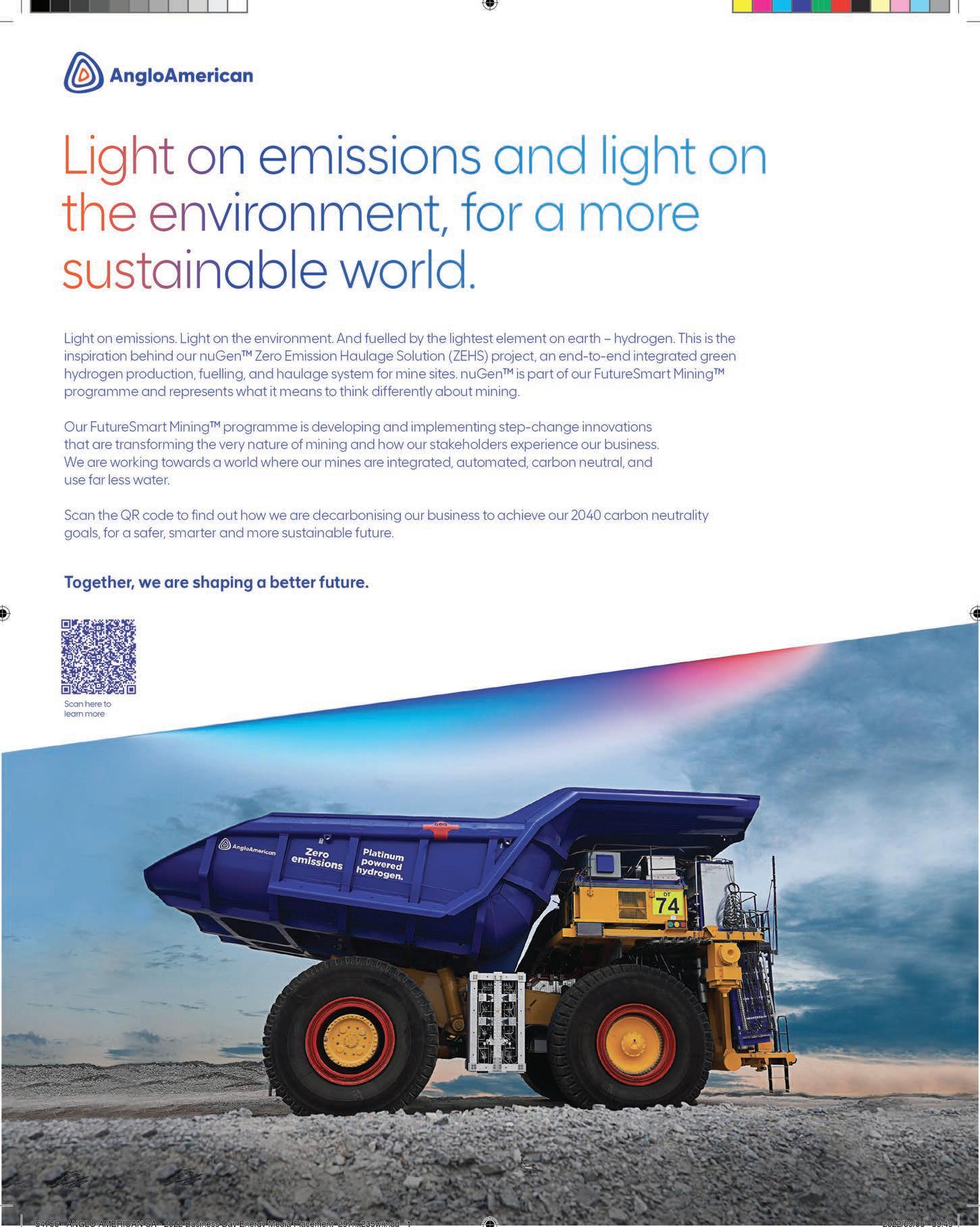
From culprit to leader in energy efficiency
PROVIDING A CRITICAL BUFFER FOR ESKOM

Member companies of the Minerals Council South Africa indicated, even before the current round of loadshedding began, that they have several thousand megawatts of renewable energy projects, worth an estimated R60 billion, planned. These, when all are built, will relieve pressure on Eskom and go a long way towards meeting the industry’s commitment to achieve net zero carbon emissions by 2050.
Eskom has suggested the utility needs to add an additional 4 000MW to 6 000MW of generating capacity. The mining industry is involved in various stages of building plants, conducting studies, planning and applications for up to 3 900MW of renewable solar, wind and battery energy projects.




Mining is one of civilisation’s oldest activities. Even in the late Palaeolithic period – also known as the Stone Age – hunter-gatherer tribes coveted valuable materials such as obsidian rock, mined and shipped across ancient trade routes. The Bronze Age rose and fell partly on the supply of tin and copper, and the Industrial Revolution started in Britain’s mining heartlands. Southern Africa is home to the oldest evidence of deliberate mining as we understand it now, when humans dug up coal as far back as 40 000 years ago.
Today, mining is a power-intensive business, consuming around 14 per cent of South Africa’s electricity output, according to Eskom. This demand is near-continual, and the industry suffers when supply is intermittent. That adds to a volatile margin that can jump significantly and quickly enter negative territory.
In an average period, these elements are challenging, but the stakes are much higher during an energy crisis, where energy costs are growing by double digits. Add South Africa’s problems with energy politicisation and Eskom,
as well as environmental concerns, and it’s a perfect storm of woes for the sector.
Yet it is also an opportunity. Few groups in modern society can combine motivation, scale and resources as mining can to effect a genuine shift in energy generation.
“Mining companies are moving towards sustainable, renewable sources of energy to reduce their carbon footprint and ensure the minerals they produce are globally acceptable,” says Allan Seccombe, head of communications for the Minerals Council South Africa (MCSA).
“There is a strong element of reducing exposure to electricity sourced from Eskom, which generates more than 80 per cent of its electricity from coal, bringing with it carbon tax, and social and environmental consequences. By having their own sources of renewable energy, mining companies have access to dedicated sources of electricity and are better able to project future costs, something they cannot do with Eskom.”
A future energy champion?
South African mines are grabbing energy by the horns, prompted by the energy crisis,



“There is a strong element of reducing exposure to electricity sourced from Eskom, which generates more than 80 per cent of its electricity from coal, bringing with it carbon tax, and social and environmental consequences.”
– Allan Seccombe
Compared to the planned 1 600MW the industry spoke about during 2020, this is a massive jump of 146 per cent in the number and size of renewable energy projects now underway.
(Source: Minerals Council of South Africa)
environmental pressures and the easing of energy legislation. According to the MCSA, 29 of its members are working on a combined 89 projects totalling 6 106 megawatts (MW) at a value above R97-billion. Those are significant investments that few other sectors could muster.
That total is still marginal compared to mining’s total energy needs. For example, Impala Platinum uses around 3 864 gigawatt-hours (GWh) of energy for all its sites, Seriti’s coal operations consume 750GWh, and Sibanye Stillwater’s needs sit at 6.59 terawatt-hours. Suffice it to say that renewables won’t completely meet the energy demands of the sector, nor are the current options entirely suited to that purpose –especially wind and solar.
“Solar alone is not sufficient, as mining operations operate around the clock and are energy intensive,” says Johan Theron, Impala Platinum’s group executive for corporate affairs

24 ENERGY
Despite its energy-guzzling image, the mining sector is shaping up as an important catalyst for energy effi ciency, writes JAMES FRANCIS
Smaller sites, such as the 100MW Mogalakwena Solar PV Plant in Limpopo, and larger 2000MW+ sites will feed into larger energy ecosystems.
MINING’S ENERGY CONSUMPTION
South Africa’s overall energy consumption:
• Distributors: 42.9%
• Industrial: 21.3%
• Mining: 14%
• International: 7%
• Residential: 5.7%
• Commercial: 5%
• Agriculture: 2.8%
Source: Eskom Integrated report 31, 2021
and strategy. “As a stand-alone technology, solar requires significant energy storage, which is currently cost prohibitive.”
Yet it’s folly to expect renewables simply to replace existing energy generation. In the book How the World Really Works, author Vaclav Smil encourages us to think of energy density as the main benchmark for replacement. For example, an aircraft would have to add significantly more weight in batteries to match the energy density of aviation fuel. If like-for-like transitions aren’t feasible, energy systems will require major redesigns – something the mining sector emphasises out of necessity.
“Renewable energy systems such as wind, solar and hydro power, coupled with energy storage and gas-to-power base-load systems, offer a far better solution,” says Theron. “The trick is to optimise the design so that renewables are maximised, with enough storage, where gas-to-power provides dispatchability and better control.”
Not all interventions are at the generation level. Mines are also chasing energy optimisation. Anglo American is currently piloting its nuGen Zero Emission Haulage Solution at the openpit Mogalakwena Mine in Limpopo, converting heavy haulage trucks into 2MW fuel cell battery hybrids that run on hydrogen. Given mining’s extensive supply chains, these projects can create ripples. For example, Anglo American is collaborating with an Australian rail freight enterprise to study the impact of integrating nuGen beyond mining sites.
Anglo American said in a statement: “We expect hydrogen and electricity from renewable energy sources to progressively displace diesel and petrol for vehicles and other machinery. The economic development associated with these changes could provide the backbone for creating a hydrogen economy in the region, thus helping to drive South Africa’s just energy transition.”
Energy beyond mining
General Electric built the original commercial power generation sites 140 years ago, first in London and then in New York. These were centralised out of necessity, wiring surrounding early adopters directly to the generation sites. In time, electric grids and other standards settled
into place, and the world has run off monolithic and centralised energy systems ever since.
But the status quo is changing. The Center for Strategic and International Studies notes that “decentralised renewable energy models offer an opportunity to circumvent political bottlenecks, provide affordable electricity, and reduce reliance on imported fuel”.
Of course, building decentralised generation capacity is still expensive and arduous, and requires a long-term mindset. Mines could be important catalysts in this regard.
“The mining industry is an intensive energy user that requires stable power and often owns large areas of land that could be viable for the development of renewable energy,” says Linda Khuluse, Seriti’s communications, media and brand manager, commenting on the mining company’s recent majority-stake acquisition in renewable energy asset management firm Windlab. “The blending of our existing coal assets with renewable energy assets is not only the first step in our journey to becoming a diversified energy business, but it is also able to provide Seriti with a sustainable self-generation solution.”
This answer reveals two trajectories for mining. Foremost, it needs to develop energy infrastructure that can support stable power and reduce dependence on external providers.
But there is also the opportunity for mines to diversify beyond their core operations. They could even end up selling power back.
“With the most recent policy changes announced by the president, space has further opened for the Impala Platinum group to assess additional renewable energy purchases and the possibility to wheel this across the national grid to our operations in South Africa,” says Theron.
Mines are also realigning their core business to support energy transitions better. Sibanye Stillwater calls this a shift to mining “green metals” that are key for manufacturing energy components such as batteries. It collaborates on initiatives such as the Rhyolite Ridge project, which provides materials for electric vehicle supply chains linked to companies such as Ford.
“Not only is the industry looking at the energy sources it uses to produce minerals, but there is also more focus on which minerals will feed into sustainable energy supplies,” says Seccombe. “In South Africa, we have platinum group metals, vanadium, copper, nickel, manganese, and other minerals that are used for renewable energy and battery applications. Without these minerals and others like lithium, for example, the world cannot achieve its energy transition goals. Mining is a critical part of the energy transition.”


Mining houses are investing R97-billion into 6 106MW of energy generation, primarily renewables such as wind and solar.

ENERGY 25 MINING
IMAGES: SUPPLIED
Anglo American’s zero-emission vehicles hydrogen production, storage and refuelling complex at Mogalakwena incorporates the largest electrolyser in Africa and a solar PV field to support the operation of the haul truck.
“The mining industry is an intensive energy user that requires stable power and often owns large areas of land that could be viable for the development of renewable energy.”
– Linda Khuluse


Mining’s transition to renewable energy
In order to overcome the ongoing power crisis, mining companies are actively diversifying their energy mix. By MINNETTE LE ROUX , environmental specialist, and NICOLAS MARSAY, B-BBEE, economic development and localisation specialist at NSDV

did not have economic value at the time of disposal. However, in recent years, new technologies have been developed that can treat this discarded material, turning it into an economically viable commodity while reducing the long-term environmental impact and rehabilitation cost.
In 2021, the mining industry directly employed more than 450 000 people, with more indirect jobs in the supply chain supporting the industry. The social impact that mines have cannot be underestimated, with many unemployed family remembers reliant on the wages of those employed. With the introduction of the principle of the circular economy, it is possible that the mining sector can increase its positive social impact through job-creation opportunities, while simultaneously reducing its overall environmental impact.

Unlocking new generation
Government has come to the party with the latest presidential announcements removing the 100MW cap for independent power production, unlocking more than 80 confirmed private-sector projects with a combined capacity of over 6 000MW.
The shortage of electricity supply in South Africa is a huge constraint on economic growth and job creation, deterring investment and reducing economic competitiveness within the country and the mining sector. In order to overcome this obstacle, the sector has for the last decade been actively diversifying its energy supply by transitioning to renewable energy.
Mining companies have been engaging renewable energy independent power producers (IPPs) on how to supplement their energy supply and reduce the risk to their operations from
Eskom’s unpredictable electricity supply. Until recently, regulations prohibited large-scale projects from being developed in the standard power project way, where the mine simply purchased energy from the generator. Self-generation was permitted, but this didn’t fit into the business model of IPPs selling power through a power purchase agreement. Likewise, the intermittency of
renewable energy makes load planning a challenge. However, with the cost of energy storage decreasing, on-site storage is becoming more economically viable.
Recently, there have been a number of examples of success stories, such as Sturdee Energy’s 75 megawatt (MW) deal with Sedibelo Platinum Mines and SOLA Group’s 200MW deal with Tronox. However, as an indication of what is to come, EDF has signed a deal to generate up to 5 000MW for Anglo American, whilst Seriti Resources acquired the majority stake in Windlab Africa, which has a renewable energy project portfolio of 3 500MW.
Areas for improvement
Whilst the industry has made great strides on the renewable energy front, there are areas where sustainability is lagging. Mining is of course an extractive industry, which through its efforts permanently changes nature itself.
The ore that contains the targeted mineral also contains other material, which is discarded on mine residue stockpiles and deposits – collectively referred to as MRDs.
The reality is that the material on these MRDs
This move is an excellent step towards ensuring energy security, and will enable private investments in electricity generation to rise to higher levels. There are still challenges to iron out, such as wheeling through the distribution and transmission networks of Eskom and local municipalities, and how to account for tariffs within the National Energy Regulator of South Africa framework. Also problematic is the time it takes for energy projects to receive the necessary approvals.

The presidency, through Operation Vulindlela, has been playing an active role in engaging with all relevant stakeholders to find solutions within the current legislative framework. Special legislation is also currently being tabled in Parliament on an expedited basis, to address the legal and regulatory constraints around new generation capacity.
This includes reducing the regulatory requirements for solar projects in areas of low and medium environmental sensitivity. Just as crucially, it will allow for Eskom to expand power lines and substations without needing to obtain environmental authorisation in areas of low and medium sensitivity, and within strategic electricity corridors.
Government has come to the party with the latest presidential announcements removing the 100MW cap for independent power production.
THOUGHT LEADERSHIP: RENEWABLE ENERGY 28 ENERGY
Minnette le Roux
Nicolas Marsay
IMAGES: BRIANBROWNIMAGES/ISTOCKPHOTO.COM, SUPPLIED
Rewiring the economy fairly
South Africa’s CO2 emissions are double the world average. Alongside extremely high levels of poverty, inequality and unemployment, this puts our country in the unenviable position of being a global outlier. While our developmental challenges have not necessarily arisen from high CO2 emissions, nor can they solely be solved by reducing these, they do share common origins.
The country’s high emissions, poverty, inequality and unemployment reflect the fact that our economy has for too long been structurally extractive and exclusive. It is vital to turn this approach on its head via collaborative efforts focused on creating a regenerative and inclusive economy.
The so-called “just transition” presents opportunities to address these developmental challenges in a systemically sustainable manner. It has the potential to be a new and sustainable engine for growth, as well as a net generator for respectable jobs, which can contribute significantly to poverty eradication and social inclusion.
There is also the significant risk that without such a just transition, South Africa will not achieve the low-carbon, environmentally sustainable economy that is essential to the well-being of future generations. For instance, South Africa’s carbon-intensive economy faces mounting trade risks and decreasing competitiveness.
The Carbon Pathways research undertaken by the National Business Initiative estimates that South Africa could lose 50 per cent of its export value, more than 1 million direct jobs

and 15 per cent of GDP if decarbonisation is not deliberately pursued.
In fact, according to a 2020 report by the World Economic Forum, Why the Crisis Engulfing Nature Matters for Business and the Economy, it is estimated that more than half the world’s total GDP is dependent on a healthy natural environment, with 60 per cent of Africa’s GDP highly or moderately dependent on nature. Yet between 1970 and 2016, the stock of natural capital for African countries fell by an average of 65 per cent.
Additional investment
To address climate change and support and protect biodiversity, Nedbank has made several investments and commitments aimed not just at mitigating environmental risk, but also driving a positive transition that can create jobs and business opportunities. Most notable is how the bank is accelerating its efforts to finance renewable energy solutions, in order to support socioeconomic development and build climate change resilience.

In April 2021, Nedbank became the first bank in Africa to release an energy policy that will see the bank make an orderly exit from fossil fuels over time, while scaling up renewable-energy financing to meet our energy supply needs. For South Africa to achieve net zero by 2050, the energy sector will need to decarbonise fully while many other important sectors, such as transport, will
Mike Davis
need to electrify. The implied financing needs in this transition, and subsequent new business opportunities for lenders and investors, are significant. This presents major opportunities for growth and investment across the country.
Lessening the impact
The impact on jobs and opportunity for job creation is a key part of a just transition, and one that is not without challenges. With regard to coal, South Africa’s strategy is not to eliminate coal entirely, but to see no new power plants built after 2030,and 80 per cent of capacity closed by 2050.
While this will result in fewer jobs in this sector, a recent PwC report entitled What a ‘Just Transition’ Means For Jobs in South Africa identified more than 850 000 job opportunities in the renewable energy sector alone. Mitigating the impact of climate change also protects 400 000+ jobs in nature-based tourism and related areas, as well as 800 000+ agricultural jobs.
Of course – as in any transition – there will be winners and losers. An orderly, just transition seeks to soften the landing for those most-impacted sectors, their employees and related supply chains. The role of financial institutions in rewiring the economy is simple, albeit not easy: to steer capital towards economic activities that support the future we want, and away from activities that do not. The decisions the finance sector makes today, in terms of capital allocation, will help shape the economy of tomorrow. This is a massive responsibility, and one that the sector should not take lightly.
THOUGHT LEADERSHIP: THE GREEN ECONOMY ENERGY 29
It is vitally important that efforts are made to double financing efforts within the green economy, writes Nedbank CFO MIKE DAVIS
IMAGES: GALEANU MIHAI/ISTOCKPHOTO.COM, SUPPLIED
Agriculture’s leap towards the sun
The agricultural sector was an early adopter of alternative energy sources, but although the case for switching to solar gets stronger by the day, how much of the sector’s power can realistically be obtained from the sun, asks LINDI BOTHA

Looking at it from an investment point of view – never mind load shedding –renewable energy ticks every box for the agricultural sector, says Simon Grier, director of Villiera Wines.
Villiera Wines’ solar panels are among the oldest installed within the sector. After being warned about Eskom’s impending troubles back in 2010, Grier made the decision to start installing a solar power system that could at least keep the lights on in their tasting room on the farm. Since then, the system has been expanded to cover 1155m² of rooftop space, providing power to the storerooms and cellar as well. This has reduced the winery’s Eskom bill by 50 per cent.

Grier believes the business case for investing in solar power will only grow stronger. “Prices have come down by two-thirds since we started with our project in 2010. On the Eskom side, however, the situation has only deteriorated and prices are rising.”
Argon Poorun, an energy analyst at GreenCape, says that alternative energy is being driven largely by rising electricity tariffs, particularly for farms in Eskom distribution zones. “Tariffs have increased by around 50 per cent since 2017, and can range from R1.50–R5.50/kilowatt-hour (kWh), depending on the season, time of use and category of connection. Compare this to the economies of scale on provision of solar energy, which ranges from R0.75–R1.50/kWh for systems in the 50 kilowatt-peak (kWp) to 1 megawatt-peak (MWp). “Given the big difference in electricity provision rates, return on investment on solar is strong and typically we see payback of five to seven years, sometimes even less on systems of more than 700kWp,” states Poorun.

A GreenCape report on the large-scale renewable energy market in South Africa states that 10 per cent of all installed solar photovoltaic (PV) systems in



IS THERE A CASE FOR HYDRO POWER?
South Africa is a water-scarce country, yet there is still room for hydro power, especially when it comes to 24/7 availability of energy. Water as an energy source is vastly underdeveloped locally. Since it comes in two-to-three times more expensive than solar power in terms of upfront costs, these systems are mostly overlooked. One project in the Eastern Cape has, however, made a strong case for developing more hydro power systems in farflung communities that have access to a constant, strongly flowing body of water with a large enough net elevation drop.
The Kwa-Madiba plant near Mthatha is housed in a retrofitted shipping container, next to Thina Falls. It provides enough electricity for approximately 50 rural households by generating electricity using the potential and kinetic energy of water. The release from the turbine room is equal to the flow at the intake structure, namely 150 litres/second and is therefore not a consumptive use. The success of this project provides a useful roadmap for implementing similar projects elsewhere in the country.
South Africa are in the agriculture sector, with an estimated investment of R630–R960-million in 2018. This amounts to a total installed capacity of 60MWp and is predicted to grow at 10 per cent annually. The biggest opportunities are for sectors in agriculture that have constant high energy demand, such as cooling facilities.
 Argon Poorun
Argon Poorun
30 ENERGY
“If you have ample sun and can secure the system from theft, then it’s a no-brainer. The sun’s energy is free and there are no surprises in terms of rate increases.”
– Simon Grier
OUR SOLAR LANDSCAPE
• Over 6 300MW of solar energy capacity has been procured to date.
• Close to 3 000MW of generation capacity connected and feeding into the national grid.
• Over R190-billion in investments have been attracted, over 25 per cent of which originate from international sources.
• The market in installation, operation and maintenance of rooftop PV is estimated at R2-billion.
• Currently there is more than 94MW of installed rooftop PV in South Africa.
Source: GreenCape
Growing needs
According to the Eskom Integrated Report of 2018, the agricultural sector made up 2.7 per cent of Eskom sales, which is about 5 730 gigawatt-hours/year. In comparison, the mining sector uses 14.2 per cent and residential consumers 5.8 per cent. During 2021, however, demand for Eskom power increased by 5 per cent while supply decreased by 2.2 per cent, hence alternative power solutions becoming all the more attractive.
Chris Schutte, director of green power company Sonfin, notes that since farming activities are becoming increasingly mechanised, power requirements have increased. Businesses going solar, however, have the added benefit to the economy of not only reducing their reliance on the national grid, but feeding power into it as well.
“More and more South African farmers are becoming ‘prosumers’ – not just consumers but also producers of electricity,” says Schutte. “These prosumers are known as small-scale embedded generators (SSEGs), and will typically install either a rooftop or ground-mounted
WHO WILL BENEFIT?
solar PV system to supplement their energy requirements from Eskom. Any excess power produced from the solar systems is then passed back to the grid.”
Poorun explains that there is an emerging trend of “agrivoltaics”, which is an umbrella term that includes rooftop, ground-mounted and above-crop PV systems. “The latter may sacrifice on energy yield due to the angle of the panels, but can provide other benefits to the crops such as shading. Another less common application is floating solar, which can be built on bodies of water such as dams, to provide a dual benefit of also reducing evaporation. We expect to see all of these systems growing in future, due to the strengthening business case for solar PV in the agricultural sector.”
Not quite independent
While supplementing a large portion of one’s energy needs at times is feasible, going completely off the Eskom grid is not as easy. Poorun points out that an important consideration is that solar on its own does not provide resilience to load shedding. “The economics for shielding against load shedding, or even going off-grid, are very different. Lithium-ion storage currently costs R6 000 to R10 000 per kWh. To put that into perspective, for a small farmer’s system of 30kWp, costing around R600 000, to have shielding against stage two load shedding, they would need to upgrade to around 80kWh at a cost of R800 000. This easily doubles the total investment in the solar, making going off-grid exorbitantly expensive.”
Schutte does not believe going solo on solar is feasible either. “Most farmers have seasonal usage trends, using most of their power in the summer when they irrigate their crops, and very little power during the rest of the year.

This means that they will have to invest in an off-grid system to cover their maximum demand on any one day of the year. The rest of the year, when they use less power, it will result in a large portion of unused capacity in which they had to invest.”
Load shedding aside, for those wanting to utilise the SSEG facility, patience will be required to get approved and connected. Solar systems must be approved by Eskom and registered at the National Energy Regulator of South Africa for legal connection. Since demand for such approvals is currently far above the capacity at Eskom, waiting times can be lengthy.
Nuts and bolts
Solar systems and parts are becoming cheaper as demand grows. Availability has, however, hit a snag as a result of the Russia-Ukraine war, with some parts now requiring a six-month waiting period. This has halted Grier’s plan to expand his solar system further, since he is now competing with demand from Europe, which is scrambling to replace Russian energy with locally produced renewable sources.
As solar power becomes more viable, more technicians are specialising in this field and expertise to have systems installed is getting easier to find. That said, Grier still cautions those looking at solar power to ensure they get the right advice, compare prices and invest in quality systems with guarantees. Once installed, however, minimal maintenance is required and most of the monitoring can be done online.
“If you have ample sun and can secure the system from theft, then it’s a no-brainer. The sun’s energy is free and there are no surprises in terms of rate increases,” Grier concludes.
AGRICULTURE ENERGY 31
IMAGES: PANARAMKA/ISTOCKPHOTO.COM, NATALIIA GORSHA/ISTOCKPHOTO.COM, SUPPLIED
“More and more South African farmers are becoming ‘prosumers’ – not just consumers but also producers of electricity.” – Chris Schutte
The farms on which energy-hungry agricultural activities are taking place are also those that stand to benefit the most from solar PV installations. These include: • Irrigation farms • Packaging facilities • Abattoirs • Food processing plants • Mills • Intensive poultry production • Intensive milk production • Farms with cold storage facilities for products such as fruit, vegetables, milk and meat Source: Sonfin
Going off-grid is ideal but it will cost you
South Africa’s energy crisis is on everyone’s lips, closely followed by the idea of freeing oneself from the electricity grid. But is it possible to do so, asks ITUMELENG MOGAKI
Everyone in the country despises load shedding, from individual households through to the commercial, industrial and agricultural sectors. When the lights go off, we feel helpless and enraged, and start thinking about alternative energy sources. However, not everyone has the deep pockets to afford installing independent power options.
Asked if going off-grid is a feasible option for the average household, Aloysha Minnaar, owner of solar photovoltaic (PV) supplier Neotronic Technologies, gives a resounding yes. However, he cautions that although the cost of the hardware has reduced over the last few years, it can still be quite pricey to implement.
“Technology is improving at a rapid rate and solar systems for the home can be started off strategically, fi rst putting the basics in place and then scaling up over time as the funds become available.”
Residential alternative energy considerations


Explaining what is involved in truly going off-grid, Minnaar states that consumers can start by reducing their overall reliance on the grid over time. “Most importantly, going completely off-grid requires substituting grid electrical supply with self-production systems such as solar or wind, for example, meaning you need to start with the basics.” He says installing a solar power source requires investing in an inverter and solar panels, and choosing a system that has been designed to meet your specific needs. If storage is required, you’ll need batteries too.
As for longevity, Minnaar says the lifespan of a system can vary greatly, from three to 15 years. “This depends on the initial technology installed, the maintenance scheduling and the actual workmanship involved. Maintenance should be monitored continuously, with specifi c tasks being scheduled at least once a year. This includes things such as checking
FAST FACT
Industry is the main electricity consumer in South Africa (52 per cent), followed by the residential sector (20 per cent) and the services sector (15 per cent).
Source: Enerdata
system performance and corrosion, and cleaning the equipment.”
Cost is of course a big factor. Minnaar says there are many variables to be considered, all of which will affect the total cost of going off-grid. “These include hardware selection, installation location and labour costs, along with any other special considerations. As a ballpark cost, a fully installed, state-of-the-art solar system for a residential property will cost R30 000 per kilowatt on average, including energy storage.”
Sibusisiwe Maseko, senior agriculture analyst at GreenCape, which supports businesses and investors in the green economy, suggests that the decision to procure renewable energy sources for residential purposes should be based on the answer to the question: What will really happen if you don’t do it? This involves taking into account whether or not the residential area is used for business.

32 ENERGY
“Going completely off-grid requires substituting grid electrical supply with self-production systems such as solar or wind, for example, meaning you need to start with the basics.” – Aloysha Minnaar
Aloysha Minnaar
“If the decision is personal, maybe ask if it’s really worth it,” says Maseko. “For example, where power could be gone only for a couple of hours, you must then ask if that will impact your home negatively.” On the other hand, she sees a different perspective if a business is involved. “At a business level, loss of power may mean loss of earnings. For example, if you are operating machines to produce products and you don’t want that to be interrupted, then it may be worthwhile to invest in alternative renewable energy solutions, such as solar PV or a wind energy system.”
Heavy power users
The ongoing bouts of load shedding have also impacted other arenas, with a significant increase in interest in renewable alternatives from commercial, industrial and agricultural businesses. Maseko says that solar PV is still the primary renewable of choice due to its wide availability across South Africa, whereas wind is context and geographic specific, as is hydro power.
Giving an example in agriculture, Maseko says: “One of the things we have seen primarily in the farming sector is that the installation of solar PV is usually for very specific farm activities, such as powering irrigation systems.”
Shoprite Holdings, one of Africa’s largest supermarket retailers, is a heavy power user. Shoprite group sustainability manager Sanjeev Raghubir says the company’s decision to invest heavily in renewable energy was influenced by a number of factors, including climate change and how their customers would be affected by pricing. “When we started putting together our sustainability strategy, we knew climate change was going to impact our businesses and supply chain

ELECTRICITY COST-SAVING TIPS
Sibusisiwe Maseko of GreenCape shares the following energy tips for residential areas areas:

• Look at energy-reduction options, such as replacing your traditional lightbulbs with LED lights.
• Switch off unused plugs and lights in rooms where power is not used often.
• Have a timer on your geyser.
• Use a gas heater or gas stove instead of a fan heater.
• Install an uninterrupted power supply if you are a hybrid worker, to get you through those dreaded hours of load shedding.
“If you want to use solar energy, it’s also important to consider that the panels themselves only generate energy according to the time or availability of solar radiation,” says Maseko. “So it’s not truly a solution to go off the grid, unless you were to get batteries for storage, which is a significant additional cost as well.”
somehow, because when you have inclement weather – regardless of it being drought, floods or heavy rains – it also impacts your products in as far as not being able to supply that fresh produce.
“Anything affecting price that we are not able to deliver to our customer then impacts our purpose. As a result, we asked both how we could mitigate climate change and reduce our carbon footprint, as well as how we could actually adapt to climate change.”
FAST FACT
In 2020 renewables generated just 10.5 per cent of the South African national electricity total. This should have grown to about 11.5 per cent by now with the completion of more plants.
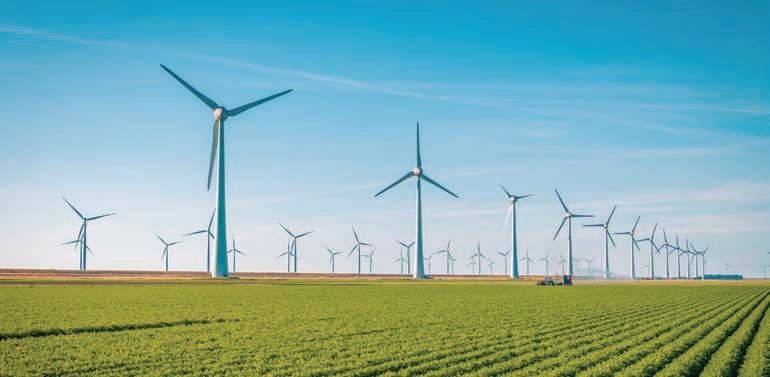
Source: Council for Scientific and Industrial Research
Cost-saving approach
Raghubir says that today Shoprite has 60 sites, including stores and distribution centres, with solar panels on the rooftops – six in Namibia and the rest in South Africa. “Strategically we looked at the western parts of the country, because they are drier somehow and have sufficient sun radiance to enable us to generate more electricity, but we have rolled out to other parts of the country too.”
He adds that Shoprite has invested in what is called a power purchase agreement, whereby the supplier invests the capital and undertakes the installation, and Shoprite buys the electricity from them. “We generally have a 20-year agreement with the supplier, and we have since discovered that our electricity purchases are significantly lower – between 30 and 50 per cent –than Eskom- and/or municipality-supplied electricity. Even the escalation rates on the tariffs are aligned to the consumer price index.”
Shoprite has also installed solar panels on its truck trailers that deliver goods from distribution centres to the stores. These trucks constantly have to operate their refrigeration units, which means drawing power, as does the tail-lift at the back of the truck that allows for the hoisting of goods. “By installing solar panels on the trailer, we can now switch the truck off and still have the refrigerator and the tail-lift powered. In total, we have about 1 000 trucks and 1 000 trailers with solar installed on the roofs.”
In conclusion, Raghubir explains that the company is now looking into “wheeling”, where one company generates power at a renewable energy power station, which is then “wheeled” across the national grid and into stores.
“One of the things we have seen primarily in the farming sector is that the installation of solar PV is usually for very specific farm activities, such as powering irrigation systems.” – Sibusisiwe Maseko
RENEWABLE ENERGY ENERGY 33
Sanjeev Raghubir
IMAGES: BOMBERMOON/ISTOCKPHOTO.COM, FOKKEBOK/ISTOCKPHOTO.COM, SUPPLIED
Sibusisiwe Maseko


South Africa’s electric vehicle evolution
Electric vehicles (EVs) have come a long way since they were first proposed as an alternative to internal combustion engine (ICE) cars. However, while uptake has been reasonably good in overseas markets like China, the United States and Europe, South Africa has a number of developing-world challenges –including a struggling economy, lack of jobs and an erratic power supply – that may impact the uptake of EVs.
Dr Norman Lamprecht, executive manager of the National Association of Automobile Manufacturers of South Africa (Naamsa), indicates that EV sales remain relatively small here, although the size of the market looks more respectable if the definition “new energy vehicles”, which includes hybrids, is applied. “The market remains small due to the high cost of EVs, which is why Naamsa has undertaken a study alongside the Department of Trade, Industry and Competition to help develop relevant policy options to support the industry in this regard and stimulate demand.
“The battery is currently a massive part of the cost of an EV, but as this technology improves, so we expect EV prices to come down,” adds Lamprecht. “As with all new technologies, as it improves, so greater uptake occurs, and the more prices fall.”
Lamprecht says there is growing local interest in EVs, in terms of both people weaning themselves off highly priced petrol and diesel, and adopting a sustainable choice for the future, so South Africa must adapt quickly.
“The move to electric vehicles is inevitable, as evidenced by the banning of ICE vehicles in the European Union market, the domestic industry’s top export region.
“It is vital to follow this trend, as our country cannot afford to lose its large export base, which is critical for the growth and sustainability of the local car manufacturing industry. It is also important to educate consumers about these vehicles, as well as to address any perceived issues, such as the impact of load shedding.”
This is the future
Audi, which manufactures a number of EVs, agrees that electric mobility is undoubtedly where our country’s future lies. The company indicates that the move to EVs is now a global certainty, backed by clear EV production targets from almost every major vehicle manufacturer around the world. As the age of the internal combustion engine slowly nears its end, now is the time for South Africans to be inspired by what future future of motoring will offer.
Audi also agrees that stimulating electric mobility adoption and interest must initially be done through education. It is important to
FAST FACT
In January 2022, Audi committed to progressing ultra-fast EV charging technology for South Africa – up to 150 kilowatts (kW) (DC). In partnership with GridCars, this technology is now installed in 33 venues, offering either fast or ultra-fast EV chargers. This includes four 150kW (DC) ultra-fast, five 80kW (DC) fast and 24 22kW (AC) EV charger installations.
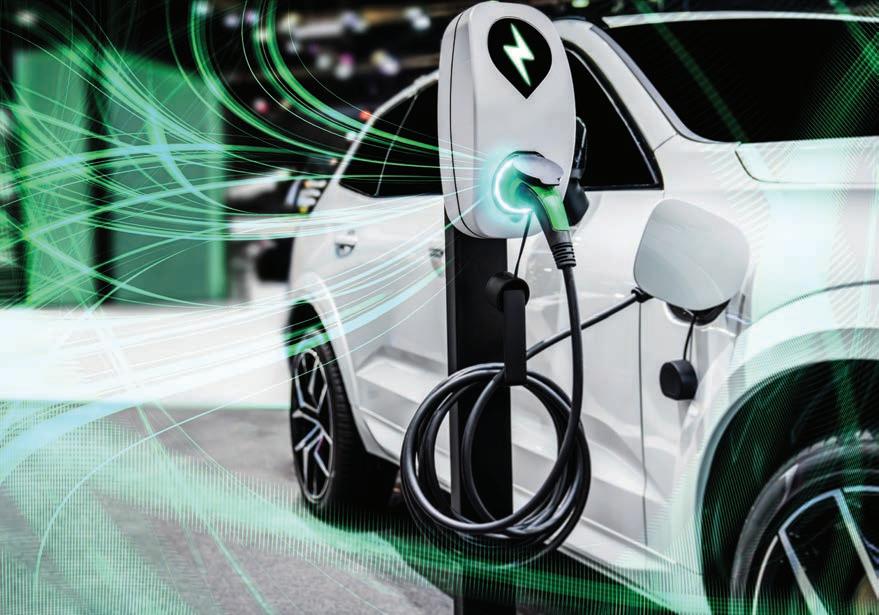
Source: Audi
open consumers’ minds to the big picture, the benefits, the opportunities and the change that is needed when it comes to mobility of the future.
People need to also be made aware that the change is coming rapidly. As of 2026, Audi will only launch fully electric new models into the global market, with a mandate to achieve net-zero emissions by 2050, at the latest.
EVs have a critical role to play in the shift to help decarbonise the planet, not only in progressing the automotive industry, but also in enabling a positive impact on the global climate change debate.
36 ENERGY
With skyrocketing fuel prices, even the least environmentally friendly of drivers may soon be considering an electric vehicle.
RODNEY WEIDEMANN unpacks the state of the market
“The move to electric vehicles is inevitable, as evidenced by the banning of INTERNAL COMBUSTION ENGINE vehicles in the European Union market, the domestic industry’s top export region.” – Dr Norman Lamprecht
Charge of the EV brigade
Broadly speaking, there’s around half-a-dozen original equipment manufacturers (OEMs) delivering EVs into the local market, according to Winstone Jordaan, MD of GridCars, which is building a national EV charging network. The cheapest of these, he notes, costs close to R1-million, with those at the top end currently retailing for around R4-million. “There are essentially only premium vehicles on the market at present, but every new industry has to grow from somewhere. In much the same way as cellphone prices came down signifi cantly as more wealthy people purchased them, EV prices should drop signifi cantly as the uptake grows. Their early adoption will make EVs more affordable in the long run.”
Jordaan adds that there is already a waiting list to buy most EVs in South Africa, and those who already own one are holding on to them. The high fuel price is also driving demand. “In the charging space, we are actually ahead of where people think we are, with around fi ve EVs per charger, well ahead of the global average ratio of 18-25. Of course we realise we could quickly fall behind, so we’re maintaining a high installation pace.
“We’re also engaging with property owners, traditional fuel suppliers and anyone else who may become part of the EV infrastructure. For us, its about helping them to understand

EVS AS A SERVICE
how and when money will be made from this sector, as well as how the new business models will work.”
Faster charging
Audi recently partnered with GridCars to finalise the installation of 33 high-speed charging stations across the country, representing a total of 70 charge point connectors.
“Audi is committed to ensuring that customers of any EV can comfortably travel the country, with the reassurance that the charging infrastructure is in place to support their progressive choice of mobility,” says Sascha Sauer, head of Audi South Africa. “With the public Audi EV chargers now formally in operation and available, our project to ensure that there are active state-of-theart chargers at key destination and lifestyle venues across South Africa is tracking well. This is hugely encouraging for the adoption of EVs in the country.”
Jordaan adds that with EV chargers, it’s a case of “If you build it, they will come”, noting that one mall told the company it didn’t require a charger installed, since no EVs came to the centre. However, it was quickly pointed
FAST FACT
The dawn of e-mobility coincides with new possibilities around customisable user interfaces within a vehicle’s cabin, including the latest in navigation, infotainment, active driver safety system technologies and car-to-x capabilities.
Source: Audi
out that since these cars are intelligent and provide an optimised plan so drivers know where the chargers are, EV drivers weren’t coming to the mall specifi cally because it had no charging point.
So when will South Africa will reach the EV uptake tipping point? “Personally, I think we reached the tipping point six months ago, when the petrol price began spiralling ever higher, both here and around the globe,” says Jordaan. “This is clearly driving greater uptake, as recognition of EVs as a more sustainable option, coupled with current and future ICE challenges, means that people are truly understanding the longer-term benefi ts of these vehicles.”
Jordaan’s advice to anyone considering switching to EVs is simple: “The transition is coming, so inform yourself properly via credible sources, seek out quality information about the industry, and the benefi ts and challenges of ICE cars versus EVs. Armed with such data, you will be well positioned to make your decision at the most suitable time for both your specifi c transport requirements and your wallet,” he concludes.
Everlectric is a company that believes the South Africa logistics sector is ready to transition to a cleaner, more environmentally friendly and sustainable future. According to co-founder Ndia Magadagela, they chose to be an early adopter in this space due to the global drive for the reduction of carbon emissions, and because their business is positioned at the intersection of three global mega trends:

• The decarbonisation of mobility: Everlectric couples zero-emission vehicles with renewable energy, returning substantial carbon savings.
• Electric mobility: Technological advancements and reduction in the cost of EVs are driving the shift to electric mobility.
• Assets as a service: There is an ever-increasing shift to a shared-asset economy.
Magadagela notes that with the as-a-service model, customers receive fully maintained and insured electric vehicles, charging infrastructure and green electricity in an easily adoptable
alternative to their existing ICE fleets. “The success of the model is demonstrated by Woolworths announcing it will transition the majority of its last-mile food delivery fleet to EVs, in partnership with Everlectric and DSV. The vehicles will start delivering to Woolworths customers in Gauteng, Cape Town and Durban over the next six to 18 months. “This is a great first step towards achieving Everlectric’s vision, which is to accelerate the electrification of the South Africa automotive industry by proving a viable ecosystem for the logistics industry’s transition to electric mobility,” concludes Magadagela.
AUTOMOTIVE ENERGY 37
IMAGES: BLUE PLANET STUDIO/ISTOCKPHOTO.COM, SUPPLIED
“In the charging space, we are actually ahead of where people think we are, with around five EVs per charger, well ahead of the global average ratio of 18–25.” – Winstone Jordaan
An Everlectric delivery vehicle
Ndia Magadagela



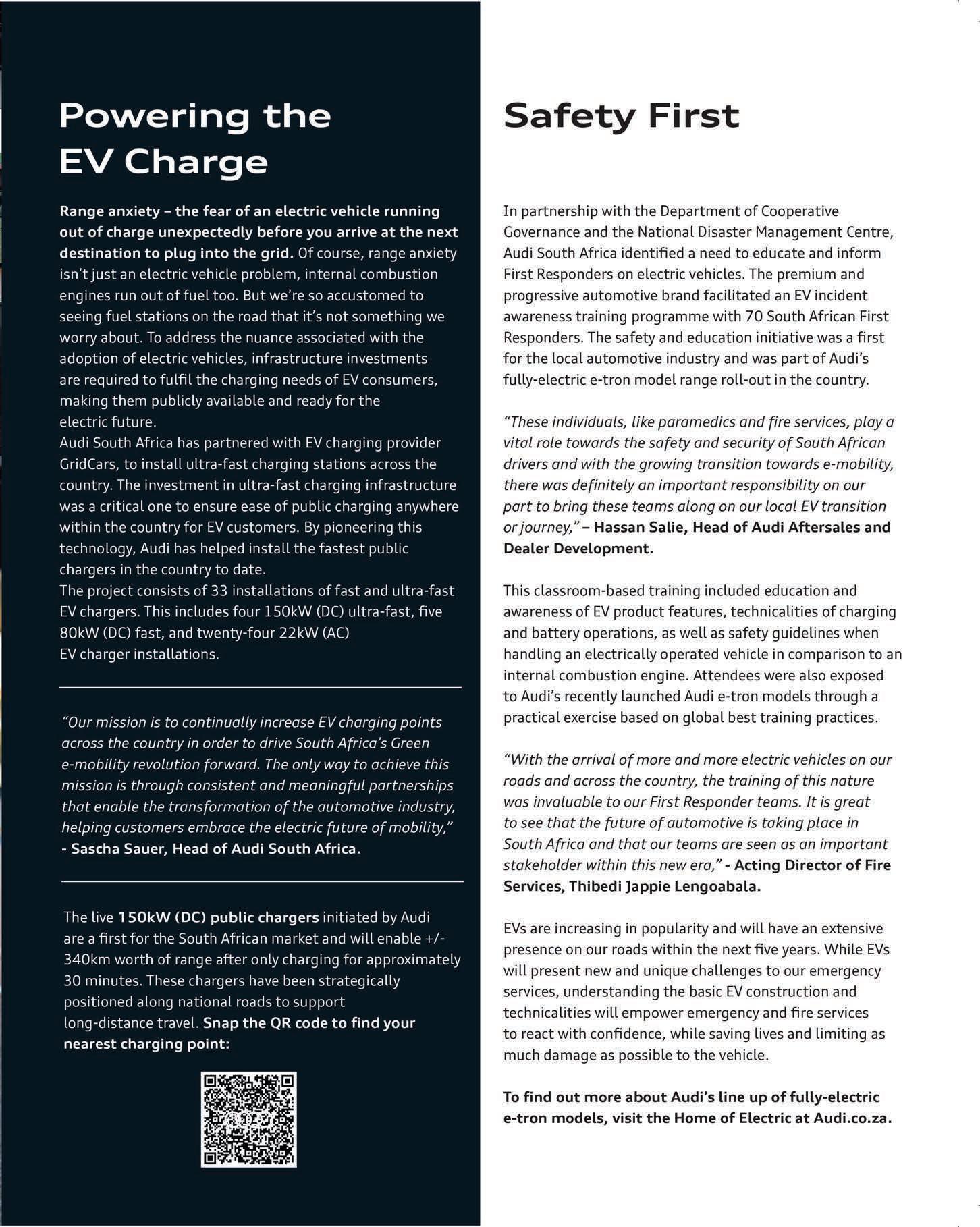

The importance of investing in energy
Investment in the renewable energy sector is vital, but questions remain around how to obtain funding, who to talk to for finance and the impact of foreign investment, not to mention how SMEs can benefit from those sustainable initiatives most likely to obtain funding. BENJAMIN VAN DER VEEN investigates
The world’s energy sector heads towards 2023 having seen both the best and worst of possible transition outcomes over the past couple of years.
On the upside, the COVID-19 pandemic, and the resultant international and national travel restrictions temporarily curtailed the world’s carbon emissions. The pandemic also helped demonstrate the value of clean energy sources, which proved more resilient to the supply chain and workforce challenges created by the virus and subsequent lockdowns.
On the downside, however, as the threat of the virus faded, so a global economic bounce-back increased demand for fossil fuels, driving up energy prices worldwide and contributing to a watering-down of coal phase-out language at COP26. The results of this economic bounce-back had countries such as China and South Africa agreeing to a “phase-down” on their coal reliance instead of the preferred “phase-out” of the fossil fuel by the end of 2050.
Nonetheless, at the start of 2022, commitment towards global energy transitions was stronger than ever, with approximately 21 per cent of the world’s largest 2 000 companies committing to net-zero targets. Of course it must be recognised that at the same time, the climate challenge facing society continues to grow.
How energy has affected global markets, finance and investments
In partnership with Reuters and moderated by Andrew Lane, CEO programme leader for Deloitte Africa, Deloitte recently released its Energy Transition Trends Report 2022 Answering the question of who should bear the cost of a just transition to a more sustainable energy system, Lane stated: “Our poll reveals a broad agreement on this point, with almost 80 per cent of the sample pool saying costs should be shared by everyone rather than being shouldered by governments, businesses or consumers.
“When companies were asked to pick a particular group of actors that should bear the primary cost of the energy transition, energy companies emerged ahead of consumers and private-public finance, although the latter was seen as having an important secondary role,” Lane continued.
In short, energy consumers and private finance are seen as having less responsibility for paying for the transition. However, an interesting finding emerged when respondents were asked not who should pay for the transition, but who would actually pay for it.
“Consumers are seen as being the most likely to end up footing the costs for the transition, by a large margin, while private finance is seen as being far less likely to pay,” said Lane.
This runs counter to prevalent energy transitions thinking, which foresees a significant role for private finance. The International Energy Agency estimates its net-zero scenario could attract more than R45.8-trillion in private finance, compared to R20.4-trillion in public funding.
At a corporate level, Lane explained, most companies within Deloitte’s testing poll had already begun allocating financial resources towards clean energy and sustainability. Almost 31 per cent of these companies began this practice more than five years ago, 36 per cent of companies started investing in the last five years, 16 per cent started spending in 2022, and just 5 per cent are expected never to invest in sustainable energy or sustainability.
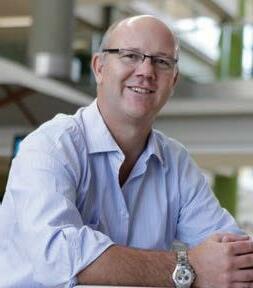
What this means for small to medium enterprises
While there seems to be an increase in small to medium enterprises (SMEs) investing in green energy on the global stage, the current question is: What are SMEs within South Africa doing to ensure they obtain the funding they need to begin shifting towards green energy? ›

INVESTMENT ENERGY 43
“When companies were asked to pick a particular group of actors that should bear the primary cost of the energy transition, energy companies emerged ahead of consumers and private-public finance.” – Andrew Lane
Andrew Lane
It is imperative to connect local SMEs to investors in infrastructure projects, and suppliers of services to these projects. South Africa’s energy transition is in its infancy, and there exist multiple opportunities across the entire value chain, including development, equipment supply, construction, operation and maintenance.

Bernard Geldenhuys, transactor for Power and Infrastructure Finance at Investec, outlines how SMEs can benefit from investment within the energy sector: “South Africa is currently facing an electricity supply crisis, with shortfalls during peak periods ranging from ±2 gigawatts (GW) in summer) to ±6GW in winter. In addition, the majority of Eskom’s generation capacity is from coal (±83.5 per cent) and in dire need of replacement.
Investment in the energy sector, including renewables, battery storage, gas and so forth, will alleviate this supply shortfall and result in reliable, cheaper and more sustainable electricity supply for all South African businesses, including SMEs.”

Geldenhuys adds that as investment in the energy sector gains traction, significant opportunities will arise across the value chain. This will include small-scale equipment manufacturing, civil works, operating and maintenance activities, and other related opportunities. In addition, there will be localised business opportunities that will significantly benefit communities where these renewable projects are being developed.
in South Africa, which presently faces an unemployment rate of around 35 per cent,” says Geldenhuys. “In addition, such investments in the energy sector will facilitate South Africa’s energy and labour transition from dirty fossil fuels to sustainable energy, and assist the country in meeting its COP26 responsibilities.”
Geldenhuys further claims that with the large foreign utilities investing in South Africa, we should also see a great deal of skills transfer and capacity building within our domestic corporates. This will in turn lead to more localisation of services needed as we roll out our renewable energy plan.
New investments
Speaking about the new investments that Investec has made within the sustainable energy and energy sectors, Geldenhuys states: “Investec’s Power and Infrastructure Finance team supports various independent power producers (IPPs) in South Africa with their roll-out of sustainable energy solutions to utilities, corporate organisations and industrial plants. In addition, we have supported black industrialists in the sector with a variety of debt solutions, to enable additional investment into the sector.
“Investec has been particularly successful in the funding solutions we have implemented in the corporate rooftop solar installation sector. This has enabled our clients to grow their asset base significantly and positioned them for sustainable growth as the market develops.”
In addition, says Geldenhuys, various other Investec divisions support small to large enterprises that often act as energy contractors or equipment suppliers to IPPs, corporates and businesses in South Africa.

Another notable investment in the sustainable energy sector is the new syndicated, multi-tranche, multi-currency loan facility for sustainable development, along with a power purchase agreement facilitating Phase 1 of Harmony Gold’s renewable solar photovoltaic energy initiative. The project was funded by a project finance debt solution from Rand Merchant Bank, with the support of African Clean Energy Developments, equity-funded by African Infrastructure Investment Managers and Mahlako Energy Fund.
Rand Merchant Bank transactor Amber Bolleurs had the following to say about the deal: “The procurement of private power by Harmony aids not only in diversifying their energy sources, but has the dual benefit of improving the overall energy shortage in South Africa. By building 30 megawatts (MW) of generation capacity for Harmony, the project liberates 30MW of existing capacity from Eskom to be used by other parts of the country that need it.”
Geldenhuys points out that there are certain sustainable initiatives that are more likely to obtain funding than others. “Energy initiatives supported by experienced sponsors, and using technologies with a proven track record in the infrastructure sector such as energy, water, transport and so forth, and with an established/ credit worthy off-taker/user entering into a long-term contract for the product/service are the ones most likely to succeed,” he concludes.
SECURING FINANCE FOR SMALLER OPERATIONS
Sponsor track records, small sponsor balance sheets and high due diligence costs make securing finance in the renewable energy sector problematic for smaller companies.
Recognising this some five years ago already, Rand Merchant Bank partnered with German state-owned KfW Development Bank to establish the FIRST Fund. This fund is leveraged and structured to improve the risk-return dynamics of a portfolio of smaller-scale projects, which helps attract more commercial bank interest for renewable projects.
Rand Merchant Bank contributed R1-billion and KfW Development Bank R300-million to set the fund up, simplifying the credit-assessment and due-diligence processes smaller companies must go through to fund their renewable energy projects.
INVESTMENT
IMAGES:
SUPPLIED 44 ENERGY
IMAGES:
GALEANU MIHAI/ISTOCKPHOTO.COM, SUPPLIED
“Foreign direct investment leads to economic growth, which in turn increases employment opportunities
“Investments in the energy sector will facilitate South Africa’s energy and labour transition from dirty fossil fuels to sustainable energy, and assist the country in meeting its COP26 responsibilities.” – Bernard Geldenhuys
Bernard Geldenhuys
Bid window 6 and the law
The announcement of bid window 6 is good news for power supply in South Africa, but there may yet be legal ramifications.

By JACKIE MIDLANE , head of banking, finance and projects; AMBER KARDAMILAKIS, director of corporate, mergers and acquisitions; and RAGHEMAH HENDRICKS, director of banking and finance, at Norton Rose Fulbright




In response to the recent bout of heavy load shedding, government announced the doubling of megawatts (MW) from 2 600MW to 5 200MW under bid window 6 of the Renewable Energy Independent Power Producers Procurement Programme (REIPPPP).
While broadly this is good news for an energy-starved SA, the actual amendment to the REIPPPP for round 6 allocation was gazetted on 9 September 2022 and confirmed by the Department of Mineral Resources and Energy (DMRE). New generation capacity to be procured under round 6 increased from 2 600MW to 4 200MW, comprising 3 200MW of wind energy and 1 000MW of solar photovoltaic energy resources. The legal reason for not increasing to 5 200MW was that the relevant concurrences from Nersa could not be obtained timeously, and the DMRE does not want to delay the bid submission date – which it has extended twice – beyond 3 October 2022.
As the various rounds under the REIPPPP are required to be undertaken according to the law, the allocation was limited to 4 200MW. While the additional energy this latest round will deliver is critical to the nation’s economic stability and growth, the process and implementation must be done in accordance with relevant legislation.
The question of exclusivity















A second area of change is the requirement for exclusivity arrangements between members of a bidding consortium. We believe this change has occurred to ensure the diversity of members in the projects ultimately selected as preferred bidders. For example, one member may have been a member of several different consortia, ultimately leading to a lack of diversity in the bids.




Now under round 6, bidders are required to choose their partner and participate as one consortium in the same projects and no others. This has created new potential challenges in terms of fundraising.
Remember that one consortium may bid for multiple projects, and if it wins all of these, will all the partners still be able to access funding for multiple projects of this nature at once?
There are tangible consequences to non-compliance, in other words bidding in more than one consortium. Failure to adhere to the rules will result in disqualification of all bids in which that entity is involved. In addition to disqualification, government also has the right to call under the bidder’s bid guarantee.

Ethical disposal requires bidders to set out the costs for dismantling the facility, disposing of solar panels and ultimately rehabilitating the land to its original condition.
After the fact




A fi nal issue to mention is the additional requirements relating to decommissioning, ethical disposal and site rehabilitation. In bid window 6, the request for proposal requires bidders to provide an on-demand guarantee in favour of the DMRE, and also to establish a rehabilitation trust to provide funds for the above.
The environmental and rehabilitation aspects of such a project need to be in place, and a detailed cost plan around how this will be achieved is part of the request for proposal. Ethical disposal requires bidders to set out the costs for dismantling the facility, disposing of solar panels and ultimately rehabilitating the land to its original condition.
While the above makes it clear that there are some areas of the latest bid window that require focused application and possible clarity from the DMRE, on the whole it is a clear demonstration that government is motivated and focused on improving South Africa energy situation.
If we can get clarifi cation on the potential legal grey areas and bidders are able to ensure the pricing is at a level that benefi ts all stakeholders, we believe we will see a boost to the economy, an increase in job creation and empowerment, and a signifi cant improvement in our power supply. Ultimately, it should prove to be a win-win for everyone.
THOUGHT LEADERSHIP: REIPPPP ENERGY 45
Amber Kardamilakis
IMAGES:
PETMAL/ISTOCKPHOTO.COM, SUPPLIED
Raghemah Hendricks
Jackie Midlane

MEET OUR ENERGY TEAM
At Norton Rose Fulbright, we have extensive experience in the energy sector and a dedicated team that can advise and assist on all legal aspects of this fast-developing industry shares
Norton Rose Fulbright South Africa

Norton Rose Fulbright South Africa has a dedicated and skilled projects and project development team. In addition, we can call on extra expertise and experience from our global practice. We have been a driving force behind an unprecedented number of successful transactions in the South African energy transition, delivering regulatory expertise, corporate and fi nancing transactional advice, intuitive South African business law acumen

and a competitive edge to sponsor and lender clients in the energy sector.
Our experience in the energy sector has been gained by advising on all aspects of the development of the industry, its diversity refl ecting the changes in the sector through privatisation, new models of regulation and fi nancing, and increasing internationalisation.
We are market leaders in the South African government’s various energy procurement programmes. Over the various
WHO WE ARE, WHAT WE DO
Corerepe consequ oditia quunte conecae reperovit vellaut laut voluptatem et, sanduntemque venda sed eossimu pte nem eaqui quas nobit, intor aut fugit, ad quas audit, su Event ilitat dolliqu undesto toria ex evelit mod ut eum faccum fugit audio cum qui tem eossitat ea comnis nonem. Et ut voluptas eruptatem quid que volorrovitis sit maio. Ut que rest, sequatisquis molectesequi quis a non conseque renisi cum aceperum comnisque venditis derum que et lacearcium vendigni volupta nistiis plici ra culpa dolut essimodi conem et qui
bid submission phases of the South African Renewable Energy Independent Power Producer Procurement Programme (REIPPP Programme), of all the bidders selected as preferred bidders to date, we have advised on more than half of these projects on a mix of sponsor, lender and contractor mandates.
AFRICAN CONTINENTAL FOOTPRINT
We offer a leading commercial legal practice throughout Africa, one of the fastest-growing economic regions in the world. We have an award-winning presence on the continent, having been voted African Alliance/Network of the Year by the African Legal Awards in 2021. We are active across key industry sectors, including power, oil and gas, renewable energy, infrastructure, mining, transportation, food and agribusiness, technology and healthcare. Our lawyers have experience working in more than 45 common law- and civil law-based African jurisdictions. They advise on groundbreaking projects and transactions and assist our clients with their ongoing commercial operations across Africa and internationally.
Complementing our energy practice are robust project fi nance, project development, infrastructure, and mining teams who, together, deliver an unsurpassed, full-service legal solution.
➔ Scan this QR code to go directly to the Norton Rose Fulbright website.
For more information: jackie.midlane@nortonrosefulbright.com matt.ash@nortonrosefulbright.com gregory.nott@nortonrosefulbright.com www.nortonrosefulbright.com

ENERGY 47 NORTON ROSE FULBRIGHT ADVERTORIAL
We have been a driving force behind an unprecedented number of successful transactions in the South African energy transition.
Norton Rose Fulbright offers a full-service banking, fi nance, and projects team boasting a diverse group of competent lawyers with offi ces in Johannesburg, Durban and Cape Town.
Clean energy, clean slate for gender equality?
Does the transition to clean energy offer the industry a chance to discard its male-dominated image and embracing gender equality, asks DALE HES
Gender equality in South Africa’s energy sector is being hampered by aeons-old issues of discrimination and stereotyping, along with a lack of hands-on mentorship for increasing numbers of bright young women looking to break into the field. Successful female energy role players say that, in light of the transition to clean energy, the industry has a better chance of discarding its male-dominated image than traditional engineering sectors such as mining and manufacturing. But this is only possible if the men in positions of power are prepared to embrace the change.
In his foreword to the 2021–2025 Women Empowerment and Gender Equality (WEGE) Strategy for the energy sector, Minister Gwede Mantashe unequivocally highlighted how gender diversity in the corporate environment could increase profit margins: “Research has presented compelling evidence that lack of women in top roles sees leading firms miss out on profits. Companies that have executive committees with female membership of more than 33 per cent had a net profit margin over 10 times greater than those companies with no women at this level. Clearly inclusion of women in business is no longer a luxury, but an economic imperative.”

Despite the strong business case confirming the correlation between performance and gender diversity, women are still severely
under-represented in the global energy sector. In the gas and oil sectors, for instance, women comprise only 22 per cent of total employed personnel, and occupy just 17 per cent of positions in middle management and senior leadership. The fossil-fuels industry is only behind construction (11 per cent total female employment) in its levels of gender disparity.
The WEGE strategy aims to “facilitate the development of mechanisms and interventions by DMRE for the creation of an enabling environment, equality of opportunities, mainstreaming of gender equality and barrier free workplaces, illustrative of a transformed energy sector”.
The strategy has therefore been warmly welcomed by women working in this world of men, particularly those who have climbed the steep ladder to success. But more than a year since it was devised, the hurdles standing in the way of its implementation are still significant.
Biases run deep
There exists an unconscious – and sometimes conscious – bias in our society that is magnified within the energy sector: that women cannot be employed because they have to pick up their
kids from school, that they are overly emotional, and that they cannot balance their work and life accordingly. So says Mamosa May, CEO of the Dorper Wind Farm in the Eastern Cape, which was one of the first projects in the Renewable Energy Independent Power Producer Procurement Programme.


May says that while the WEGE Strategy pillars are sound, the lack of invested sponsorship for up-and-coming women from the people (mainly males) who command the industry prevents them from being upheld. “Young men in their developmental phases often get sponsors who show them the ropes, nurture them and impart their business skills. We need sponsors who can identify young women, hold their hands and get them through the growth phase. Not just mentors who may offer advice; we also need the practical experiences of learning from failure and building confidence in business.”
“The energy sector pie is so big that there is space for everyone, with different perspectives providing different benefits.” – Mamosa May
48 ENERGY
Gwede Mantashe
Mamosa May
May’s experiences of bias and its multiple knock-on effects have been similarly noticed by decorated nuclear physicist Senamile Masango. Hailing from KwaNongoma, a rural town in KwaZulu-Natal, Masango rose to become the founder and chair of Women in Science and Engineering in Africa, and the chairperson of the South African Nuclear Energy Corporation, among many other accolades.

“We are fish who are competing with sharks,” says Masango. “Because women don’t get the support they need, they give up easily or decide to stay pinned in their own small corners. Most women don’t go out there and network. They may have the passion and incredible ability, but not the confidence, because that has been trampled.
“You barely ever see a female energy expert being interviewed. Even with my years of experience, when I am approached to give my views on the energy sector, I still think twice, because there are concerns about how I am going to articulate myself and how I may be criticised by the males in the industry.”
Opportunities in the clean energy transition

The entrenched attitude of the established oil and gas industries presents a difficult challenge for gender parity, but the transition to clean energy may be creating a refreshed and more conducive platform. In its 2019 Renewable Energy: A Gender Perspective report, the International Renewable Energy Agency found that women represent 32 per cent of full-time employees in the renewable energy sector, still low in comparison to some other industries, but a major improvement over fossil fuels.
The WEGE Strategy also specifically recognises that “gender diversity and the broad participation of women in the energy sector are needed for a successful clean energy transition”.
“Gender mainstreaming is a huge topic in the renewables space, so the future looks much more promising in terms of gender
equality, when compared to established industries,” says May. “We are seeing extraordinarily high levels of innovation, passion and expertise within the science, technology, engineering and mathematics fields, and an increase in the number of workshops, and mentoring and networking opportunities for women in the space. One thing is for sure: the energy sector pie is so big that there is space for everyone, with different perspectives providing different benefits.”
Masango, meanwhile, is forging her own exciting new path in renewables, having recently opened her own consulting firm focusing on clean energy solutions. “I want to utilise my own skills to provide advisory solutions as we transition to cleaner energy, and finding solutions is where the key lies for women. We have a right to complain about gender equality, but at the same time, we as women scientists and engineers have the capabilities to provide practical solutions to these issues.”
Men must help to engineer the path With men occupying the majority of leadership roles, the transformation of the energy sector cannot take place without the male will to support women empowerment.
May says that workshops and networking sessions have a danger of being stereotyped by the industry as “women’s clubs” with feminist stances. “Gender equality and the transformation of hiring practices need to be a joint discussion. Women should not have to take it upon themselves to drive opportunities, and often they do not have the influence to do so. We need to identify men who are passionate about uplifting women in the energy sector and who realise the value for the business bottom line.”
The WEGE Strategy contains a detailed implementation plan that applies to South
ENORMOUS EMPLOYMENT OPPORTUNITIES
The International Renewable Energy Agency estimates that the number of jobs in renewables could increase from 10 million to around 29 million by 2050. Because of its multidisciplinary dimension and its links to more liberal societal norms, the renewable energy field exerts an appeal to women that the fossil fuel industry may lack. However, despite the appeal, women face persistent barriers to entry, and to remain in the workforce and advance. These include:
• Perceptions of gender roles
• Low levels of women enrolled in science, technology, engineering and mathematics education
• Lack of access to career information and relevant networks for women
• Skewed hiring practices and access to employment entry points such as internships and apprenticeships
• Lack of a supportive environment in the form of flexible work hours, family-friendly work practices, mentoring and networking, training opportunities, and gender equity targets
Source: Gender Equality story: 2019
Renewable Energy: A Gender Perspective report from the International Renewable Energy Agency
Africa’s entire energy sector, including the Department of Mineral Resources and Energy, state-owned enterprises and private-sector companies. If effectively implemented, the strategy “will ensure that women in South Africa participate in the full value chain of the energy sector as investors, owners, managers, workers, academics, consultants”. To ensure participation of both public and private companies, Mantashe has established a Gender Ministerial Council to oversee and drive the implementation of the strategy.
“Government has again created a strong legislative and institutional framework, but we need firm commitments from all stakeholders in the energy industry. Energy is one of the biggest challenges for South Africa and the world. If women are adequately represented across the value chain, we may go some way towards finding solutions to this challenge through differing perspectives that contribute to a representative, diverse transition to a clean energy mix,” Masango concludes.
GENDER EQUALITY ENERGY 49 IMAGES: WANGANQI/ISTOCKPHOTO.COM, SUPPLIED
Senamile Masango
“Because women don’t get the support they need, they give up easily or decide to stay pinned in their own small corners.” – Senamile Masango

















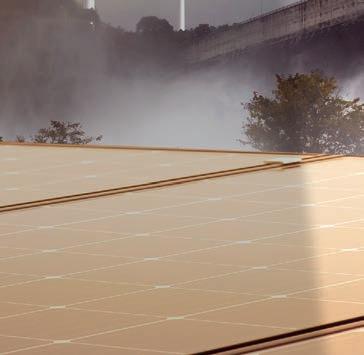






ENERGY PUBLISHER PICASSO HEADLINE, A PROUD DIVISION OF ARENA HOLDINGS (PTY) LTD Hill on Empire 16 Empire Road (cnr Hillside Road), Parktown, Johannesburg Postal Address: PO Box 12500, Mill Street, Cape Town, 8001 Published in April 2023 To advertise in the next issue of Energy, please contact Gavin Payne Sales Project Manager Tel: +27 21 469 2477 | Cell: +27 74 031 9774 | Email: gavinp@picasso.co.za
Are renewables the answer to South Africa’s job crisis?
FAST FACT
The danger for the South African renewables space is in not investing as a country, but rather just creating maintenance and execution jobs to set up infrastructure. That’s the view of Mark Victor, risk advisory director: sustainability leader at Deloitte.
“Our opportunity sits in understanding the broader value chain and developing an intentional strategy, as a country,” says Victor. “Importing solar panels and creating jobs by upskilling installers is a narrow view, so we need to look at the value chain: mining of raw materials, local processing, manufacturing and recycling.”
Understanding that value chain is the key to building a sustainable industry and creating jobs on the scale that we need to, both to supply the power the country needs and help the green sector contribute to righting our dire unemployment numbers.
Digging for data

Wendy Poulton, secretary general for the South African National Energy Association, has been part of the team working on an energy skills roadmap for South Africa, which will be released next year. “We looked at what work has already been done on skills in South Africa and did a baseline assessment of the energy skills base. The result so far is that nobody currently has an idea of what energy skills we have in the country.


“There are pockets of information, but many of the studies are siloed and there is no national energy skills plan. The Energy & Water Sector Education Training

Authority is the skills authority for energy in the country, but they don’t know the current skills numbers or levels because players don’t submit their workforce skills plans. As a result, it’s nearly impossible to understand current and future skills needs.”
Poulton says that the quantum of skills required in the green economy and when they need to be available depend on how quickly global technology trends move. “It is anticipated that renewable energy will ramp up in the country, but when and by how much, and whether or not it will include hydrogen production as well as electricity is not clear.
“The energy sector is not only changing within the sector, but it is also ‘coupling’ strongly with other sectors – including water, transport, information and communications technology, chemicals, manufacturing and extractive industries – related to storage. This means that not only does the energy sector have to have enough skills, but also so do these sectors, if the entire ecosystem is to operate effectively.”
Victor says that policies and incentives on their own are not enough. The creation of a collaborative environment, where there’s an understanding of how and where the industry can develop, is vital to job creation. Public and private development must come together to drive intentional outcomes.

Mandated job growth
During the construction of a solar power plant, thousands of people will need to be involved and major investment will be injected into the towns closest to where the plants are being built, says Christo Fourie, head of energy strategic business unit at the Industrial Development Corporation (IDC).


Fourie says that during construction, jobs are also created through the manufacture of components and inputs. “We know that

The sixth REIPPP procurement bid window seeks to procure 11 813 megawatts (MW) of power from various sources including renewable energy, storage, gas and coal. It calls for proposals from independent power producers to develop new generation capacity of 2 600MW, including 1 600MW from onshore wind energy and 1 000MW from solar PV plants.
Source: Renewable Independent Power Producer Procurement Programme

many of these inputs are imported now. We had a local solar PV panel assembler, but they ‘went bust’ because of interrupted procurement. We’re supporting two companies that will be providing panels for future Renewable Energy Independent Power Producer Programme (REIPPP) rounds, but where most of the job creation happens is on the balance of the planning part of engineering, procurement and construction contracts.”
The IDC is also working harder to support BEE companies in the renewables space, since the majority of REIPPP bids are generally won by foreign independent power producers.
“They are obliged to partner with local BEE companies. What we want to achieve in the medium term is to help these local companies grow so they can compete head-on and win utility-scale bids in the public and private space,” concludes Fourie.


DEVELOPMENT ENERGY 51
“Our opportunity sits in understanding the broader value chain and developing an intentional strategy, as a country.” – Mark Victor
IMAGES: SUPPLIED
Christo Fourie
Mark Victor
The emerging energy sector holds enormous potential for job creation and economic development, but it is not without challenges, writes TREVOR CRIGHTON
Wendy Poulton
Tackling the energy crisis with new business solutions


this space. However, the shift from being seen as a technology only for “wealthy” people is quite pronounced, as the current energy crisis will likely drive more middle- and lower-income people to do the same.

Large-scale projects – those requiring anywhere from 250 kilowatts (kW) to a megawatt or more – demand extensive engineering, large capital costs and external funding. However, the growth of independent power producers (IPPs) has created a gap at the smaller end of the market, and SMEs should move quickly to take advantage of the growth in clients.
There are huge opportunities to be had in delivering renewable solar solutions to smaller businesses: those that require in the region of 30–90kW systems for offi ces, mini-factories and offi ce blocks. It is important to help them understand that these solutions save so much energy that it affects more than just the bottom line.
Scaling up
During stage four load shedding, the power grid goes off for around two hours at a time, up to three times during the day – usually in the morning, afternoon and evening. While any period without power is challenging, the morning and afternoon blackouts can be particularly problematic for businesses, self-employed individuals and those who work from home, who could potentially lose up to fi ve hours of work during the day. If you take into consideration that an average work day is eight hours, including lunch, these outages can cause irreparable damage to the economy and people’s livelihoods.
Clearly, we need to wean as many entities as possible off the Eskom grid, starting with businesses. South Africa’s future lies in private power generation. The good news is that our country is rich in sunshine throughout the year, meaning that renewable energy is viable. Considering that some statistics indicate most areas of the country average more than 2 500 hours of sunshine per year, solar installations as a means to cut down on electrical usage seem the obvious choice.
Remember that a solar solution can start small: Modems, pool pumps, geysers, borehole water pumps, lighting, water heating and cooking are all options that can be easily and cost effectively powered by solar. More importantly, in a country beset by job-creation challenges, there is huge potential for small and medium enterprises (SMEs) to set themselves up as solar installation services.
The next big thing
If you are an entrepreneur seeking the big business next opportunity, this is an industry you need to consider seriously. Remember that grid-supplied electricity is only going to become more and more expensive (and possibly erratic) as we move forward.
Obviously, entrepreneurs should research the industry first and look for gaps in the market. Solar panels, inverters and batteries constitute the basics, but there is a lot of competition in
Of course, how these small solutions scale is a critical question for SMEs in construction, infrastructure and manufacturing. Many of the most successful small-scale solutions are those that can be built using low-power circuits, and which are cheap to scale up. Clients save money on time-consuming building, while also receiving the personalised service for which SMEs are renowned.
Small-scale equipment is usually designed to be scalable as the initial requirements alter. This offers SME installers the opportunity to grow their solar implementations as their clients themselves expand in size. Ultimately, this means they benefit from building relationships with repeat customers. Meanwhile, small firms of consulting engineers will be in a position to add to the value chain whenever these clients begin to grow.
Everyone will agree that Eskom power utility cannot manage the country’s electrical demand alone; it needs IPPs as well. There is thus enormous potential for SMEs across the value chain to benefi t significantly from the growing demand for sustainable and renewable energy solutions.

THOUGHT LEADERSHIP: SMME S 52 ENERGY
Small-scale equipment is usually designed to be scalable as the initial requirements alter. This offers SME installers the opportunity to grow their solar implementations as their clients themselves expand in size.
IMAGES: IPOPBA/ISTOCKPHOTO.COM, SUPPLIED
Robin Melville
There is a huge business opportunity for small to medium businesses to help solve the country’s energy crisis, writes ROBIN MELVILLE , product manager for sustainable energy at Mustek








































































































































 Argon Poorun
Argon Poorun



































































































